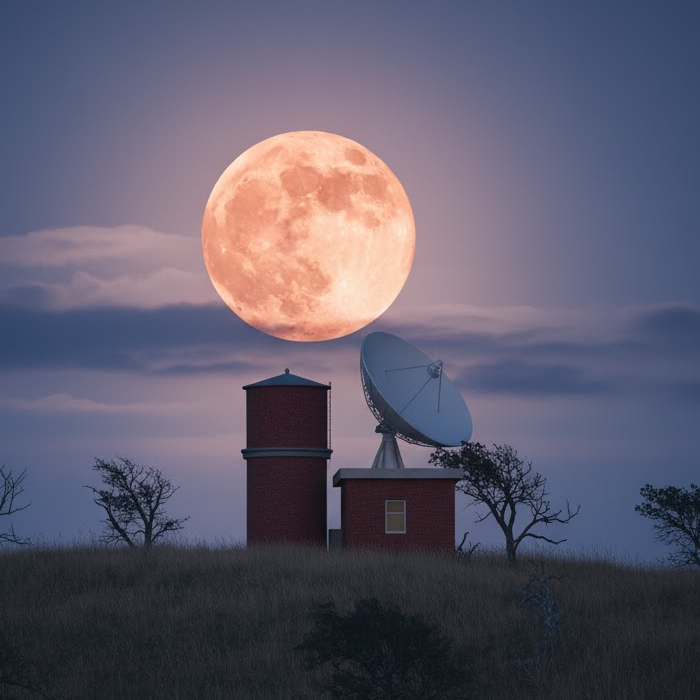
432 AND ABOVE EME NEWS
October 2025
Volume 54 Number 10
Editor: Peter Blair G3LTF
Production Assistance: Frank NC1I & Bob W1QA
News, Contests and Dx-peditions
In August 2024 I stepped in as temporary editor for the Newsletter to restart it after the death of its founder Al, K2UYH. Now, 15 issues later, it is time to hand over to someone else. With the superb work by Bob, W1QA setting up the https://eme.radio website and generating an attractive and easily read style and format, the Newsletter is again well established in the EME community.
I am delighted to say that in December Barry, VE4MA, will take over as editor.
Barry is very well known by most of the 432 and Above community. He has been operating on EME since 1979, starting on 70 cm and then up into the microwave spectrum. In 2001 he made the first 24 GHz EME QSO with Al, W5LUA and in 2005 was in the initial QSOs on 47 GHz. He operates on digital and CW and is very much a hands-on, practical, get things working engineer in tricky areas like QRO millimetre-wave TWTs.
I am sure that the community will continue to give him the same terrific support that I and the team have received in the last 15 months. I would also like to thank Dave G4RGK for the help he gave us last month when I was away on holiday at a critical time!
Congratulations to DL7YC and RW3BP
Manfred, DL7YC, reports below on another amazing first, receiving signals on 76 GHz from Sergei RW3BP. Still on mmw, 2024 has been a very active year on 47 GHz and the latest edition of DUBUS 3/2025 contains three articles on this topic.
A big thank you to Max SA5IKN who has provided the replacement to the F5SE / F1EHN Ephemeris data which is now available here: https://eme.radio/moon-ephemeris. Be sure to try the interactive link!
The ARI contest, September 20-21, was reasonably well supported with most activity on 23 and also 3 cm, unfortunately the small sun separation made things very difficult on the Sunday.
We have had two very successful dx-peditions this month, coinciding with the ARRL contest 3rd leg. HL2/LY3UM and PY0FBS made a lot of 23 cm operators very happy. (Including the Ed on CW!)
The new OK1DFC lightweight short septum feeds for the folding dishes seem to have made a noticeable performance improvement, see several reports below.
In the ARRL 3rd leg overall the highest activity by a long way was on 23 cm digital with a high number of new stations making an appearance. Several new ones from the USA, with two of them reporting here for the first time. Welcome! There were at least 9 stations with dishes of 10 m or above, hopefully in the final leg some will come on ssb. At the other end of the scale 1.5 m solar cookers were in evidence and 1 m to 1.5 m dish QSOs were made.
Highest scores reported so far (QSOs only) are OK1DFC 143 on 23 cm and OK1VUM 68 on 70 cm.
70 cm was pretty quiet by comparison to 23 cm but I note that several stations are planning to be on 70 cm for the final leg.
Contests
The final leg of the ARRL EME contest is on November 8th and 9th.
Contest Survey
Bob KA1GT has launched a survey concerning the ARRL contest and general EME operation which is running at https://s.surveyplanet.com/v48qt62p
Please take a look and take part. Results will be announced by Bob next month.
Dx-peditions
Alex EA8DBM will be operating as 8Q7UM from the Maldive Islands from November 3rd to 9th. The moon passes during the night, so he will mostly be active in the evenings, and on a couple of mornings he will be on the air as well which should give the US East Coast a good opportunity. On Sunday the 9th, he plans to be active throughout the entire moon pass. He will only be on 23 cm.
Jan, PA0PLY, proposes a 13 cm activity weekend for December 6-7th. The weekend has good common moon windows to Asia as well as to USA.
OE3JPC is planning to activate ZA on 23 cm EME
“Although Alex EA8DBM was there already I assume there is still some interest in ZA on 23 cm. We already started to plan to go there in September 2026 (+/-) with a similar equipment (and using parts of it) as I use on 23 cm at home: 2x (new) 70el YU1CF, W6PQL amplifier ~400W at the antenna, antennas stacked vertically, location JN92RD. Any support welcome.”
DC1RDB Robert
Recent 70 cm initials are PC0A and G4RGK.
After quite some time, and a lot of work, my 23 cm setup is now pretty much complete. It consists of a 1.5 m solar cooker dish, an OK1DFC lightweight septum feed, an AG6EE preamp and a PE1RKI 140W PA module.
The setup is not weatherproof, semi-portable and currently located on my patio, because I have no room for a permanent installation. This also limits my moon visibility window.
The rotator is home built from inexpensive Chinese worm gear modules and simple machined parts after borrowing some ideas and receiving tips from Paul W2HRO (thanks Paul!). It is being controlled by a very compact Az/El controller with integrated moon tracker, based on K3NG code.
I am still in the process of optimizing, but a few initials could be logged already: PA3EXV, PA3DZL, UA3PTW, UA9FAD, OK1USW, OH3LWP, PA0PLY, G4YTL, ES3RF, PA3FXB, DK3WG, RA4HL, G0LBK, ZS4TX, IZ8GGF.
 DC1RDB dish with feed
DC1RDB dish with feed
 DC1RDB dish side view
DC1RDB dish side view
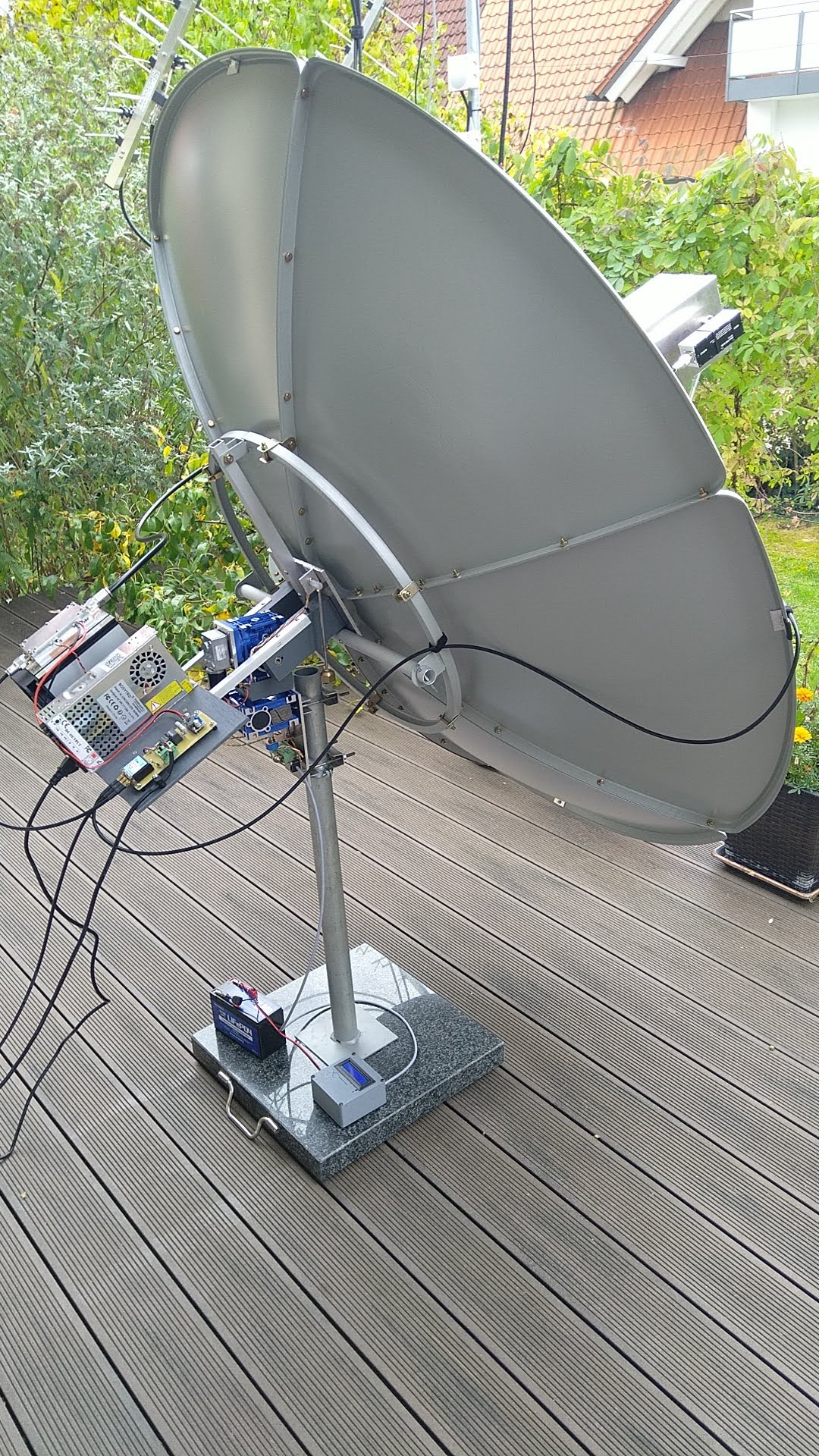 DC1RDB dish rear view
DC1RDB dish rear view
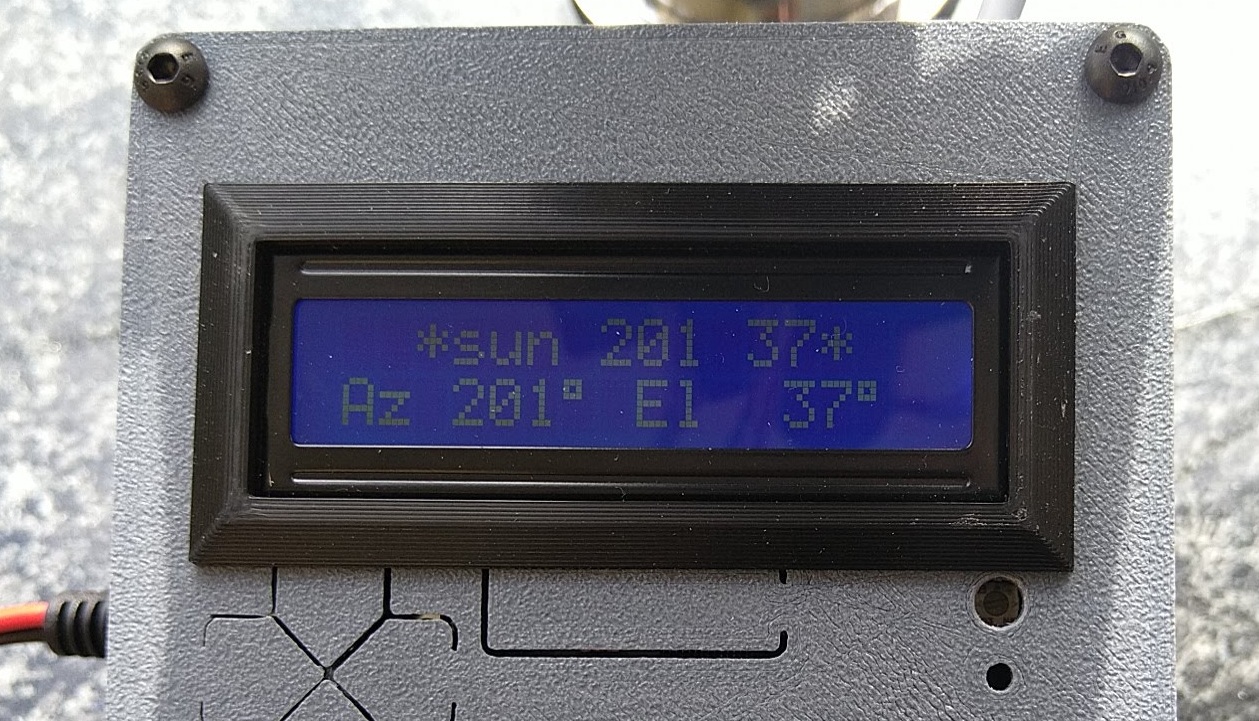 DC1RDB dish controller
DC1RDB dish controller
DJ3JJ Andreas
This year I only worked Howard G4CCH in CW. Last years I could always work up to 20 stations CW.
The rest of the stations were worked by the Computer. QMAP V0.4 showed the Stations and Q65 Mode, most were -30 dB.
10th October OK1UGA
11th October DL3EBJ, G4RFR, G4CCH
12th October HL2/LY3UM, RD4D, SP7EXY, JQ3JWF, ON5GS, SP5GDM, K0PRT, SP3YDE
13th October IK2DDR, PY0FBS, ON4LX
19th October PA3EXV, R1NW, N4BAA, DK3WG
Impressive was the Digital Signal of RD4D who moved my S Meter to S5! Would have been easy for an ssb/cw communication. Finally I could get Alex, HL2/LY3UM and Bruce, PY0FBS. For these dxpeditions the digital mode was OK.
Thanks to everybody still exchanging Paper QSLs or eQSLs. I like the personal touch.🙂
DK3WG Jurg
I worked the following new ones in October:
70 cm Q65-B - K3WM, OZ7UV, XQ3SA
23 cm Q65-C - HL2/LY3UM (DXCC), PY0FBS (DXCC#111), RD4D, W8TN, DC1RDB, N4BAA and SO5AZ.
| DK3WG 1943 - 2025 Ruhe in Frienden! |
DL0SHF Christoph
So, over the weekend of the 1st leg of the ARRL 25 EME contest I managed to be on with DL0SHF for about 11 hours on 23 cm altogether only - due to some health issues; I would have liked to do more.
I was on at moonrise on both days and stations were heard already and worked (HL/YL3MU) at less than 2 degrees of elevation; elevation is limited to over 1.6 degrees with the 9.5 m dish. Over the 11 hours I worked 58 contacts in Q65B_30s, 2 in Q65C_60s and 21 QSOs in CW for a total of 81. I had quite a number of "get-aways" which I hope to catch next leg. On the first day I was on until Moon was down to 5 degrees, and on the 2nd day down to 15 degrees.
I was happy that Per DK7LJ got the water-cooling of the PA repaired just in time and that was was not a single dropout this time.
As I am controlling a Flex6500 (I believe) over an internet connection (1 GBit and 100MBit on my side), I experienced some dropouts and software resets, where I was cut-off in the middle of some contacts, but I was back within less than a minute or so. I am sure, some of you wondered. CW is done via PC keyboard and Flex built-in keyer and sometimes the automatic keying is faster than my typing, so I stayed with 14 wpm. This Flexradio has the advantage to see immediately what is going on, especially helpful in CW.
My intention was NOT to make use of the HB9Q thing, but after calling CQ in the middle of all the bunch of stations resulting no QSO at all, I decided to announce the CQs. That's life nowadays. After I had worked all CW stations I could see, I was able to move a few CWers to answer. It was fun and I am looking for the 2nd to come.
DL1VPL Thomas
I participated in the first part of the ARRL EME competition, with a lot of rain over most of time.
From my perspective, the activity at 70 cm was lower than last year. This was also seen in the small number of spots for 70 cm in LiveCQ, compared to 23 cm.
I have only 11 stations from US, most came from Europe, only one station came from UA/UB.
Now I'm hoping for the second round. Maybe a few more OMs will move down to 70 cm.
Notable contacts were for me:
VE3CIQ (3 m dish, 200 W)
VE4MA (3 m dish, 500 W)
K3WM (2x yagi, 300 W)
OK1TEH (1x 23el, 800 W, best -26 / -23, easy QSO)
OZ7UV (4x 27el, 100 W)
NY1V (2x 22el, 425 W)
I have only 4x13el and Plisch TV-PA (750 W).
I made the observation, that stations with a -for 70 cm- small 3 m dish are not particulary strong here, but they seems to have great advances on RX!
DL3WDG Charlie
Many stations experienced problems with QMAP during the last leg of the ARRL EME contest.
This was initiated by three stations calling CQ TEST [Call] [Grid] instead of the standard format without the TEST. QMAP was not designed to cope with such a message and it caused a crash. Two of the three stations (when informed) kindly desisted from doing this, and reverted to the standard format. The third station persisted apparently leading to continuous problems for many!
A new version of WSJT-X-improved should be available in time for the last leg of the ARRL contest. This includes a fix for the above problem with QMAP and the ability to upload spots to PSK Reporter and LiveCQ (https://w3sz.com/livecq.html) from MAP65. Two new ways of changing sked frequency have also been added. (The original method is unchanged).
WSJT-X-improved is available from here: https://sourceforge.net/projects/wsjt-x-improved/
I have uploaded information on the changes to sked frequency entry here:
https://drive.google.com/file/d/1hTNW64X5xO_nWkNRYCyWCZJoBs3CaOcp/view?usp=sharing
DL7YC Manfred
On October 10 (05:22z - 05:32z) Sergei's (RW3BP) 8.1 watt WSJT Q65-60E EME transmissions at 76,032.100 MHz were decoded WORLDWIDE for the FIRST time ever by DL7YC!
At test time both sides had poor weather conditions with a light, but 100% cloud layer and sometimes drizzle. (12 C / 82% relative humidity / 1022 hPa)
The moon noise at DL7YC at that time was 0.75 dB only (normal clear sky is 1.2 dB). Sun Noise was only 7.9 dB only - normally > 10.5 dB. The test was made at the mutual libration minimum with only some Hz, for both locations!
The received report (shown on the screen) was best at -17dB.
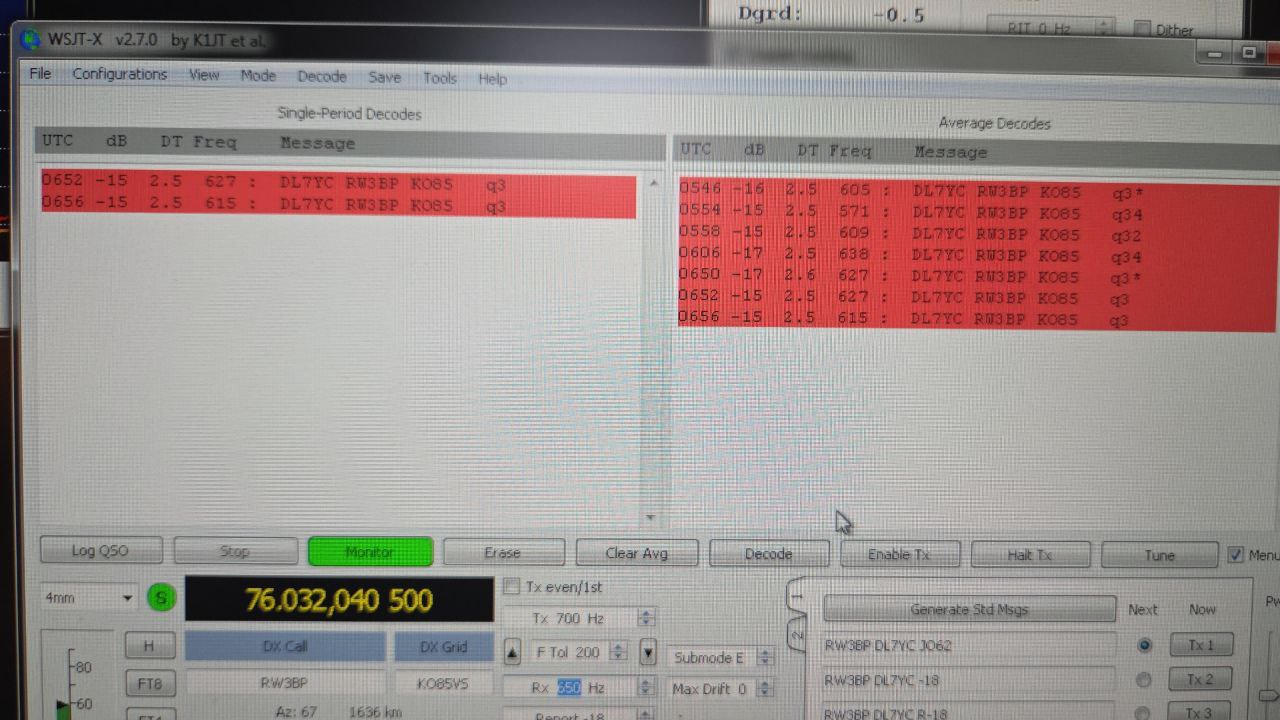 DL7YC 76 GHz RW3BP decodes 2025-10-10
DL7YC 76 GHz RW3BP decodes 2025-10-10
At 12 October 2025 (05:40z - 07:09z) we repeated the test in much higher libration conditions, but much better Moon Noise of 1.45 dB!
Again, DL7YC decoded RW3BP several times at -16/-15/-15/-17 dB.
RW3BP also transmitted two times for 5 minutes in his MWCW mode (introduced back in 2004) and DL7YC recorded to files for later analysis.
At DL7YC I used a 2.4 m precision Prime-Focus dish (f/D 0.385), RA3AQ feed, RW3BP preamp 2.4 - 2.5 dB NF, DB6NT 76 GHz transverter, SVH7 dual slewing drive, EA3HMJ Controller (ESP32 based) with 18-bit encoders, DriverDish App by EA3HMJ, RFspace SDR-14 (input IF 8.225 MHz from K3s) and SpectraVue continuum noise recognition.
RW3BP used a 2.4 m precision Gregorian Offset Antenna, optimized feeds for Tx and Rx "switched" to focal point for the period needed. The whole electronics is an integral part behind the feed, separated for the receiver and transmitter path which included a water cooled SSPA at 8.1 watt, a LNA with 2.4 dB NF @ ambient temp, compact TRV, and a homemade tracking system with high precision.
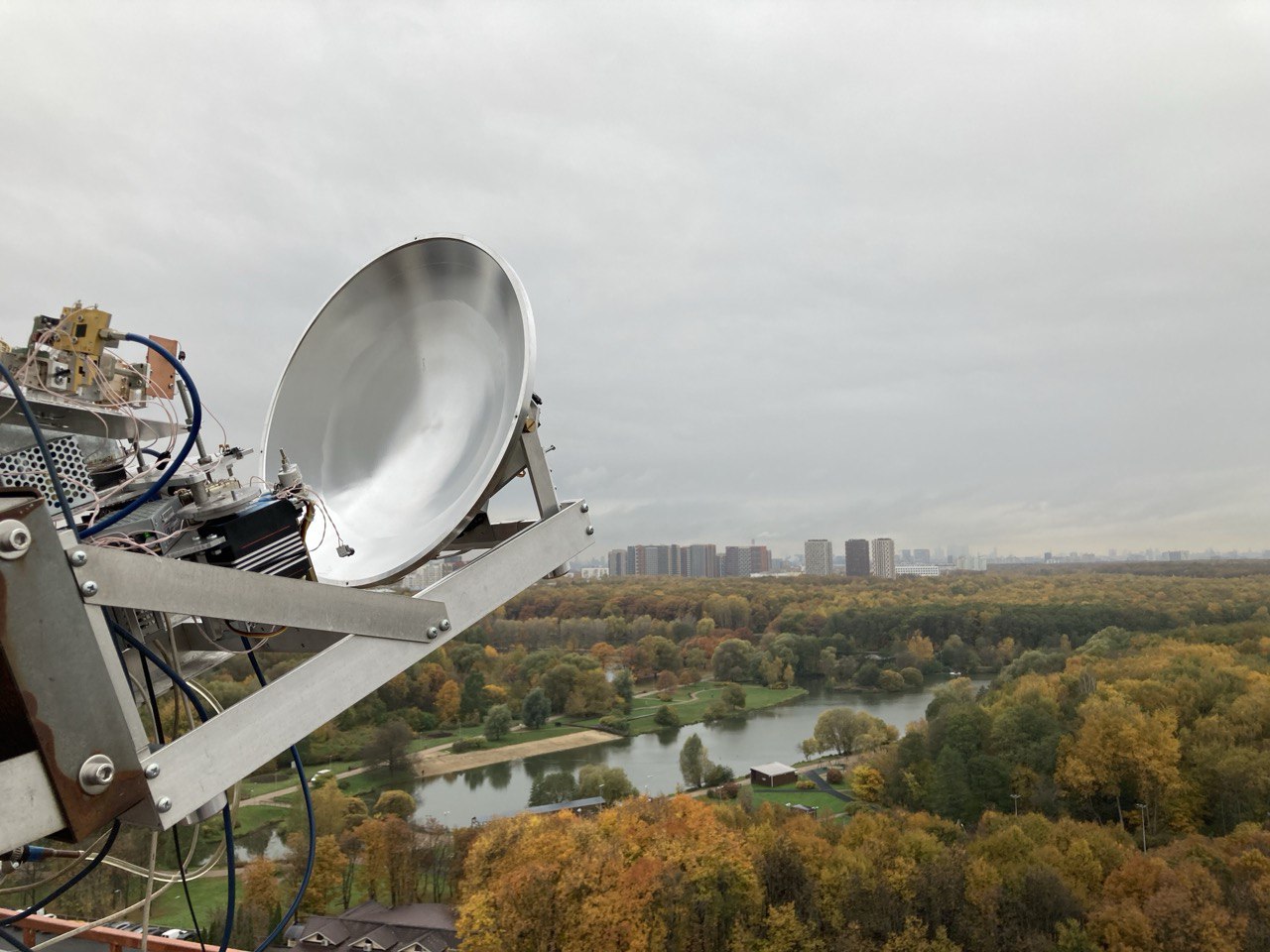 RW3BP Gregorian Subreflector
RW3BP Gregorian Subreflector
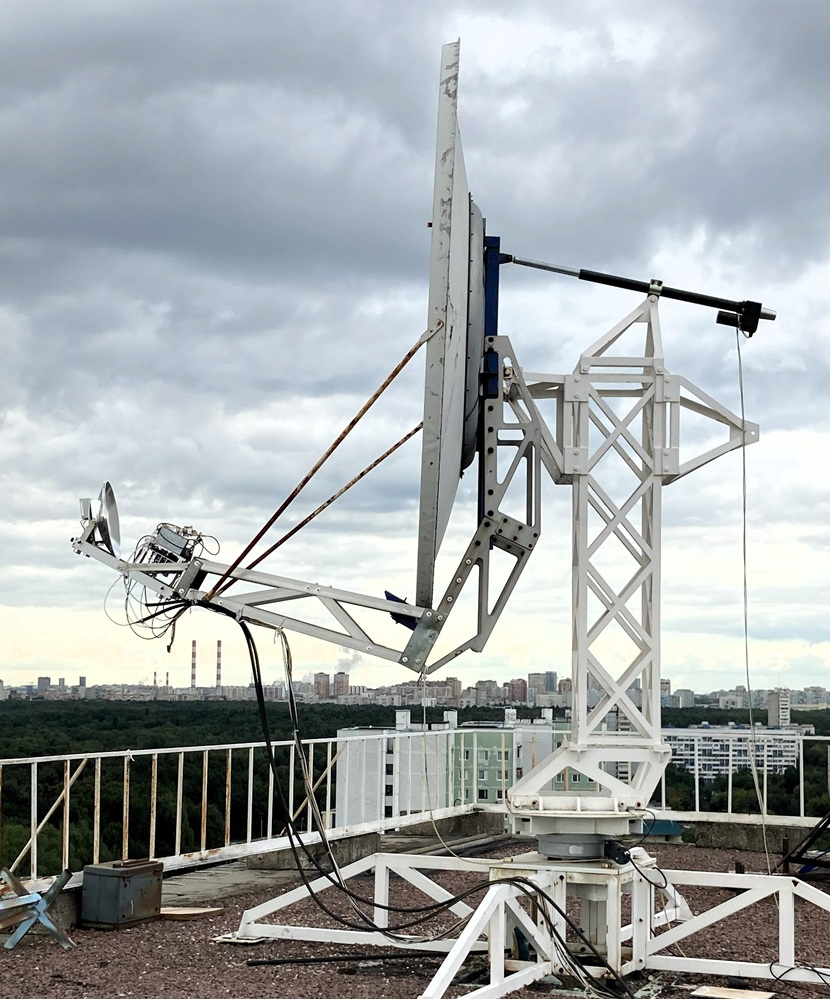 RW3BP 2.4 m Antenna 76 GHz rig
RW3BP 2.4 m Antenna 76 GHz rig
The practical target tracking is better than 1/100 degree in each direction.
![]() DL7YC tracking display
DL7YC tracking display
Several people later analysed the recorded WSJT data. For October 10, the day with the very low libration spread, Gerald OE2IGL, found with the WSJT degradation tool, a single decode with a 4 dB margin. The weather report at this day at the RW3BP side was +9.0 C, 990 hPa and 95% relative humidity. Due to the very narrow antenna beams, the effective libration spread is lower than simple calculations (like VK3UM) predicts. In this case the beam corrected libration spread was 36 Hz only (@76 GHz !!!!)
OE2IGL looked at SINGLE decodes only and found for the 12th of October a margin of only 1 dB, 1.5 dB and 2.0 dB added noise failed. CT1BYM looked to averaged decodes also and could add 4 dB of noise before decoding failed.
For the same day the recorded 5 min MWCW file showed the absolute S/N level of -21dB! It’s hard to compare all the different results and it needs further observation of signals close to the decoding threshold.
F5KUG - Jean-Louis F5DYD
F5KUG (ops F6ABX and F5DYD) had fun operating CW only on 23 cm during the 1st leg of ARRL.
We chose to be in the 23 cm multiop CW only class because we love CW. We don't make any Internet arrangements by choice: radio and only radio.
We made 33 CW random QSO and are relatively pleased with it using 3,60 m dish and 500 W at feed, The IFs are an IC735 and a pair of Elad FDM Duo. Highlights were contacts with KL6M, VA7MM, VE6BGT, VE6TA and JH5LUZ. But only a single continental US station, WA6PY. All others were EU stations.
As a feedback we would like to encourage many of you to listen and/or monitor the CW band part even for a short time. We were looking at the digital band during our RX periods with a second Elad FDM Duo (great SDR to feed MAP65 directly without additional hardware or software than FDM-SW2) and we saw a great number of Q65-60 stations with signals usable on CW (-10 dB JT or more).
We feel that finding a CW station is not so difficult now with SDRs. And to our mind the pleasure to decode the call sign and report by ears and brain is well worth the effort. You will find there some stations and multipliers not available in digital. Only basic CW skill is required as far as speed is concerned: the challenge is the weak signal and lunar QSB which can alter the characters. If you hear in your headphones the Q65 signal of a station you should be able to work him.
We hope to convince some of you to challenge this "return to the future" during the second leg.
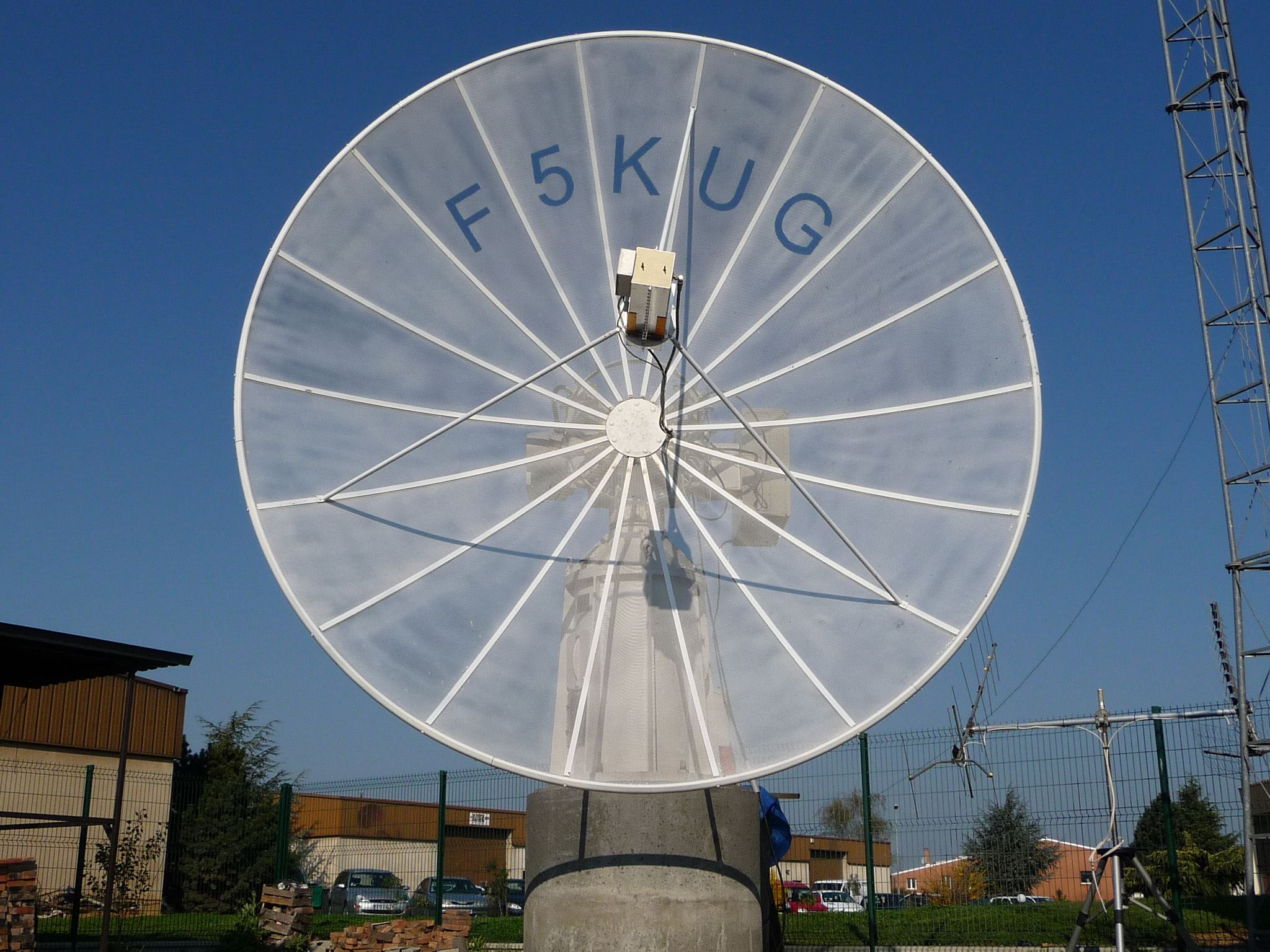 F5KUG 3,6 m dish
F5KUG 3,6 m dish
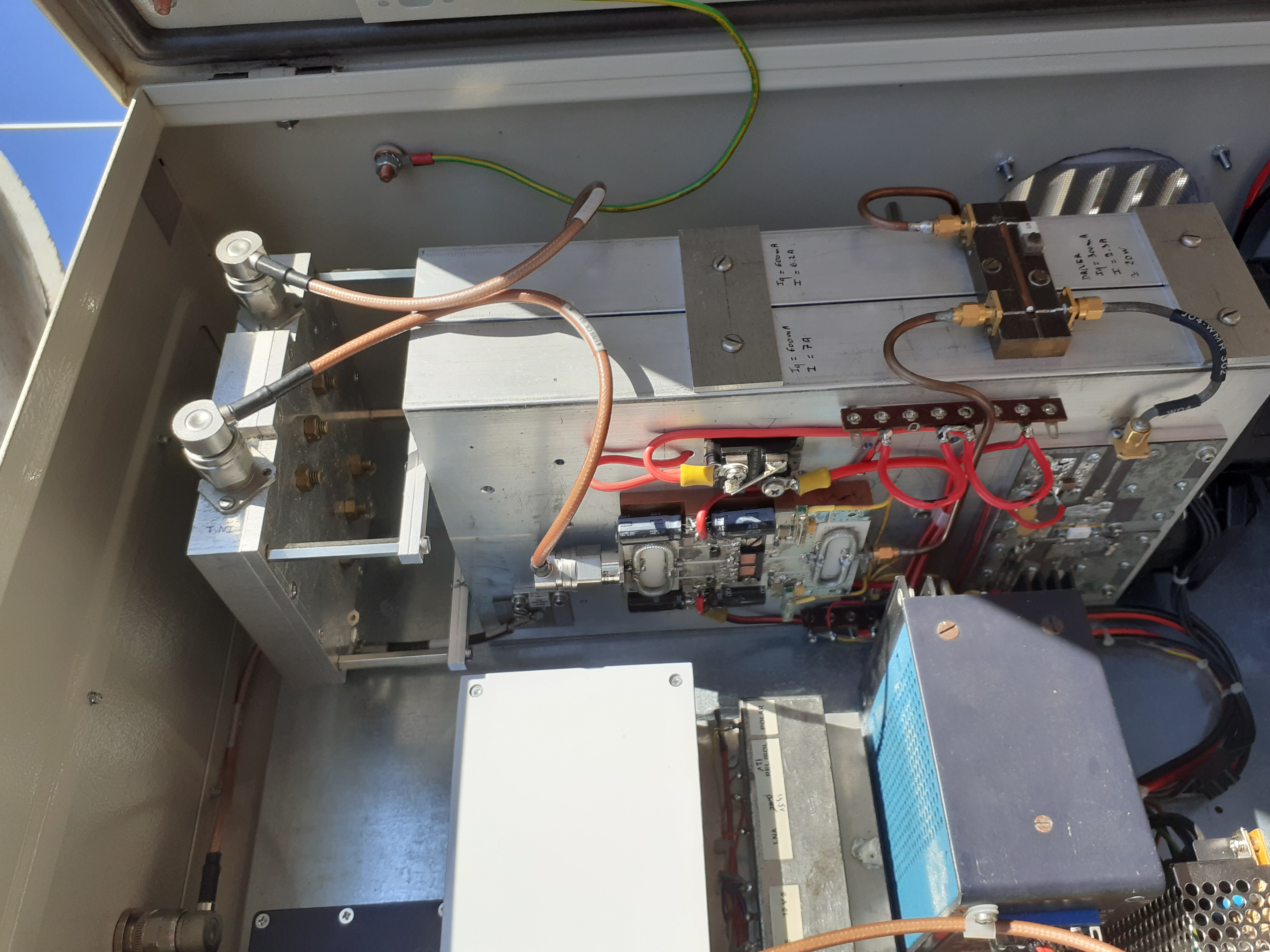 F5KUG PA
F5KUG PA
F6ETI Philippe
The lowest result from my ARRL EME participation in a long time. 13 QSOs: DL0SHF, G3LTF, KL6M, F5KUG, G4CCCH, OH1LRY, OK1KIR, SM5DGX, DG5CST, OK1DFC, LZ2US, IK3MAC, and JH5LUZ (#115).
I only started early Saturday morning and continued until moonset, then from moonrise until 2200 UTC, and resumed early Sunday morning until moonset. Then from moonrise until 2330 UTC, ending with JH5LUZ.
I called constantly, I still had my echoes, luckily they were there. Apart from the European stations, JA and KL6, nothing on the US side. Oh yes, it was Morse telegraphy, and random.
3-meter dish; 300 watts at its septum source; VLNA23 0.37 dB NF; SUN/CS 13.3 dB at SFI 122
G0JDL John
It’s been a fairly quiet couple of months for 70 cm EME here in on the east coast of England. I have managed to work three initials though, with WC8RK and KD2LGX worked in September and K4EME worked in October during the ARRL contest. Since my last newsletter contribution in August I’ve also had QSOs with DL1VPL, SM4GGC, UA3PTW, PA3DZL, JO4KVP, K5DOG, GD0TEP and ON7EQ. I wasn’t really able to do much operating during the ARRL contest due to other commitments but conditions were generally poor during the time I was on, especially for EU-EU contacts. I’m probably not going to be able to operate for long in November leg of the contest either so no doubt I’ll miss out on a few more initials. Activity on 70 cm has remained disappointingly low over the last couple of months.
Once again I’m having trouble with an SP70 preamp so I’ve decided to keep one only as an emergency spare and reconfigure my system using an Antennas-Amplifiers Advanced Sequencer and EME2-432 LNA. I hope to have this up and running by the end of the first week of November.
G3LTF Peter
I was active in the ARI contest on 20th September working on CW: IK1FJI, G0LBK, OK2PE, UA9FAD, G4CCH, DJ3JJ, SM2CEW, IQ2DB, IK5VLS, and on the 21st, IK2DDR. A total of 10.
On 10th October I was delighted to work Alex HL2/LY3UM on CW with 539/529 reports #565 and DXCC #86. On 11th October in the contest I started at 0500 and worked VE6TA, F5KUG, SV3AAF, LZ2US, NQ7B, OK1KKD, IK3MAC, SM6PGP, G0LBK, WD8HRW, VE6BGT, SP6GWN, SP3XBO, KL6M, WA6PY, IZ7EZN #566, IK3COJ, SM2CEW, VA7MM, OM4XA, SP6JLW, F6ETI, DL0SHF, G4CCH, N5BF, OH3LWP, OH1LRY, IK1FJI, JH5LUZ, I2FAK, OK1DFC, OK2PE, JJ3JHP, IK5VLS and OK1USW, continuing on 12th with SP7EXY, SP3YDE, WA6PY (dupe), OK1KIR, PA3DZL, UA9FAD, IQ2DB, DG5CST, PA2DW, OE9ERC, and K5N #567. Got-aways were KD5CHG, DL1HUH and W3SZ. The total of 45 is a bit down on last year and quite a few “regulars” missing.
On 13th October I was very happy to work on CW PY0FBS #568 and DXCC #87. Bruce had forgotten his key but got a software keyer installed and was extremely good and easy copy. Finally on 17th October I took advantage of some calm wx to check out my 9 cm system, excellent CW and SSB echoes and I worked OH3LWP for #80.
I've attached the SDR screens from HL2/LY3UM and PY0FBS. This is taken from my final IF at 14 MHz. OE9ERC’s big signal can be seen tail-ending on HL2/LY3UM, also there is the typical long fading that I see on signals from the Far East close to their moon-set.
My CW copy is done using my TS590 transceiver at the 14 MHz final IF with 150 Hz bandwidth and an external 50 Hz tuneable audio filter at 400 Hz.
 G3LTF HL2/LY3UM QSO
G3LTF HL2/LY3UM QSO
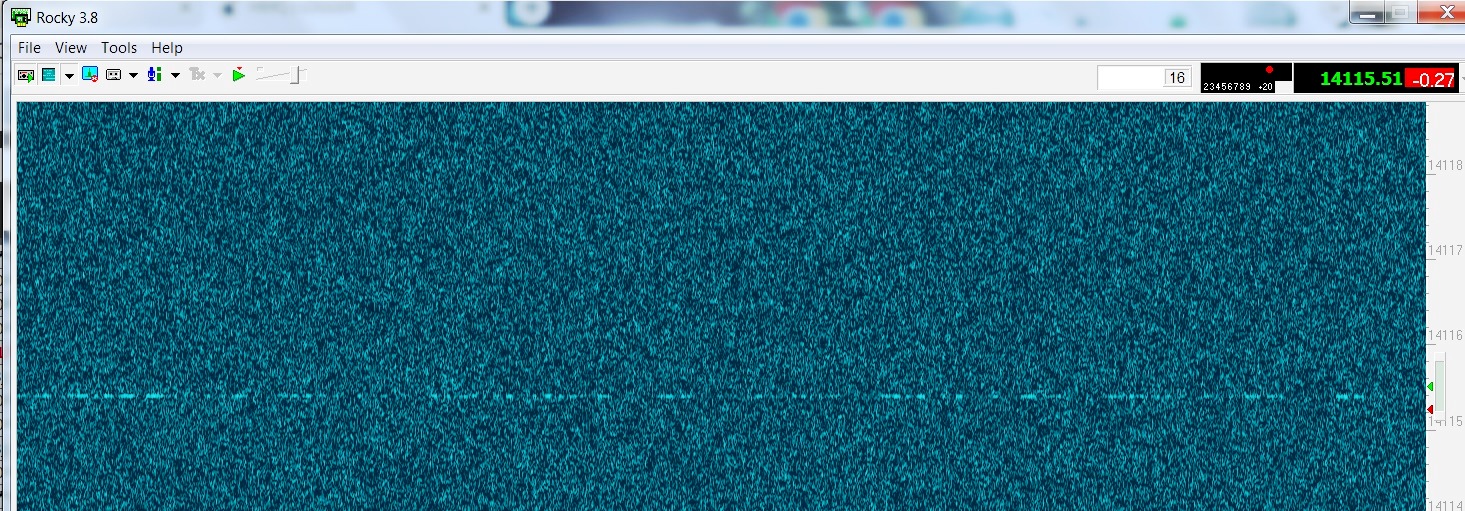 G3LTF PY0FBS QSO
G3LTF PY0FBS QSO
G3YEG Nic
For the first time for quite a while no QSO's or new station decodes this month. Eu-Eu has been consistently difficult with very poor Faraday rotation most days and the best moon times for my normal use of 9 elements at high elevation have been rather unsocial!
However I tried setting the ant in a different position in the roof with all 21 elements (similar to where I have copied VK4EME in the past) but at a lower 10 degree elevation and had some success with UA3PTW!
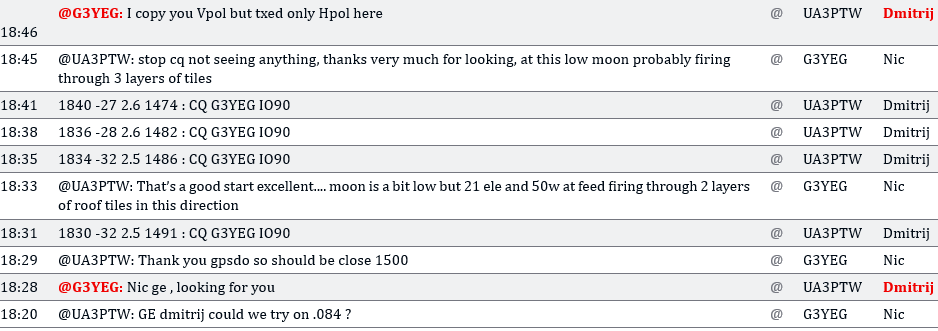 G3YEG HB9Q chat log
G3YEG HB9Q chat log
That's the first time Dmitrij UA3PTW has decoded me (which is very pleasing having failed a number of times in the past) and the first time I haven't seen him (which is annoying) - nothing at all seen and he is normally around -18 on the 9 element. Faraday was playing games, a number of others around the Eu were also seeing very poor signals. I have just 50 w at the feed of the 25 year old 21 element Tonna and my ERP is just 2 Kw.
With the low moon at the start of my test I was actually firing through 3 layers of the roof not just the normal one layer. The antenna was set as below but only at 10 deg elevation so it was actually firing through the other two layers of the second protruding roof. By 18.40 the moon was at 14 deg elevation and just starting to clear the forward roof, also I have always found that, for best results, I normally need to aim 5 degrees below the moon.
I can be contacted at
G4CCH Howard
22 August 23 cm – Worked AG7CM (D) and WA4LM (D) digi Initial #689 and on 23rd, FX5YOTA special call same as la Villette and PI9RD. On 24th Worked LY3UM (D) digi Initial #690 and LY3UM on CW Initial #581 and KB2SA and on 25th DK0VHF, DK3EE, OE3JPC (D), OZ3Z (D) digi Initial #691.
26 August 13 cm – Worked LY3UM (D) digi Initial #064 and KN2K (D) digi Initial #065
6th September 23 cm – Worked ZA/LY3UM (D) digi Initial #691 and GW4ZHI (D) digi Initial #693 and on 9th TA1/LY3UM (D) digi Initial #694 and on 10th worked VK3NFI (D).
In the ARRL EME Contest (second leg) I worked the following: on 13 September on 13 cm: SP3XBO, OK1KIR, IW2FZR, KN0WS (D), KN2K (D), VE6TA, KN0WS CW Initial #143 and G3LTF.
14 September on 9 cm – Activity was very poor. Worked DF3RU, OH3LWP (D), OK1DFC (D), WA6PY, K5DOG (D) digi Initial #26 and K5DOG CW Initial #067.
On 19 September on 23 cm I worked W3TI (D)
In the ARI contest on 20th September 23 cm worked: G3LTF, G0LBK, UA9FAD, G0LBK (D), IK1FJI, IK5VLS, SM2CEW, I0NAA (D), CX9BT (D), I2FAK, IQ2DB, SV1CAL, I2FAK. On 22nd September 23 cm worked SO5AZ (D) digi Initial #695, M0FXX (D).
On 6th October 23 cm - Sun Noise measured at 19.4 dB with SFU=137. Worked OK2AQ and on 8th October 23 cm worked HL2/LY3UM (D) digi Initial #696 and DXCC #138. I had 5 dB excess noise with the Moon at 5 deg elevation and on 09 October 23 cm worked R1NW (D) digi Initial #697, PY0FBS (D) digi Initial #698 and DXCC #139
In the ARRL EME Contest second leg, on 11th October on 23 cm: – Huge echoes! Worked: F5KUG, SM2CEW, SP6JLW, LZ2US, F6ETI, G3LTF, KL6M, N5BF, OH3LWP, VA7MM, DL0SHF, IK2DDR, OH1LRY, K9ZBU (D) Initial #699, W2ZQ (D), OM4XA, OK1USW, OK2PE, IK5VLS, DJ3JJ, JQ3JWF CW Initial #582 and SP7EXY.
On 12th October 23 cm worked SP0KKM (D) digi Initial # 700, PA2DW, KD5CHG CW Inital #583, W8TN (D) digi Initial #701, K5N (=K5QE), SP3YDE and WB8HRW. Didn’t come on for the final pass as I was getting ready to go on holiday. Will see what I can do next month.
G4KLX Jonathan
This report is a mixture of good news and bad news.
The bad news: I am now off EME for some time. My 23 cm PA has gone to low power (blown transistors / incorrect biasing?) and the original manufacturers aren't interested in looking into it because it's too old. I now have to re-evaluate my options for 23 cm, but I'm going to miss the ARRL EME contest whichever route I choose.
The good news: I've just acquired a 1.3 m offset dish with the aim of getting onto 3 cm EME. I already have a suitable prime mover, and a 10 W amplifier from my old 3 cm terrestrial system from when I operated as HB9DRD in the early-2000s from near Zurich. I have a new dish feed on its way, and I hope to get a reasonable pre-amplifier soon. The system will be coax based, but should be enough to work some of the big stations at least.
The aim is to move to a waveguide based system using DU3T modules, and move the coax based system back down to terrestrial work with a 90 cm dish. I have no timescale for getting active on 3 cm EME, or when / if I'll get back onto 23 cm EME, but at least I'm making progress.
G4RFR - Julian G3YGF
In the ARRL Contest weekend, we took part on 1296 MHz with the 3.65 m dish with 80 W.
Before the contest, on Friday 10-10-2025, we worked: JJ3JHP -15/-13, OK1UGA -5/-8, SP3YDE -9/-13, I2FAK -11/-12, RA4H -6/-22 and UA3FAD -15/-10.
In the ARRL Contest on Saturday 11-10-2025 we worked: SP3YDE -10/-14, SP7EXY -7/-10, UA1ALD -12/-16, DJ3JJ -17-/-16, W2ZQ -12/-15, R1NW -22(b-15)/-12, OK1DFC -9/-2, OM4XA -15/-18, PA0TBR -8/-12, ON5GS -8/-5, GM0PJD -11(b-9)/-12, W1FKF -12/-17, DL3EBJ -12(b-6)/-7, VE3NXK -18/-18, PY0FBS -21/-20, WA3RGQ -21(b-13)/-20, W3TI -21/-26, IQ2DB -10(b-8)/-20, KN0WS -16/-14, VE6TA -7/-11, AC2AC -15/-21, OK1USW -12/-14, HB9Q -1/-7, SP5GDM -8/-13, W3HZU -8/-13, SA6BUN -9/-12, SM6PGP-14/-20, OE5ERC -5/-20, DK4RC -2/-9, DL1HUH -8/-9, YO2LAM -9/-10 and RD4D -3/-6. On Sunday 12-10-2025 we worked HL2/LY3UM -18/-18, PA3EXV -10/-12, DL3EBJ -9/-10, DK5AI -18/-20, OZ9KY -18/-17, PA7JB -24(b-17)/-17, IK5VLS -13/-13, DM2CFH -8/-8, ZS6Y -22/-19, KA1GT -21(-16)/-16, IK7EZN -15/-18, ON4LX -??/-20, K0PRT -12/-18, W2ZQ -17/-21 and AA6I -18/-14.
There was some interference on Saturday AM, then around 0600 on Sunday, all EME signals seemed to fade out, and we got bad radar QRM for several hours. We can't explain the drop in EME signals, other than a very strong inversion forming above us. Conditions only reappeared later, when the band seemed full of signals, allowing us to work W2ZQ and AA6I.
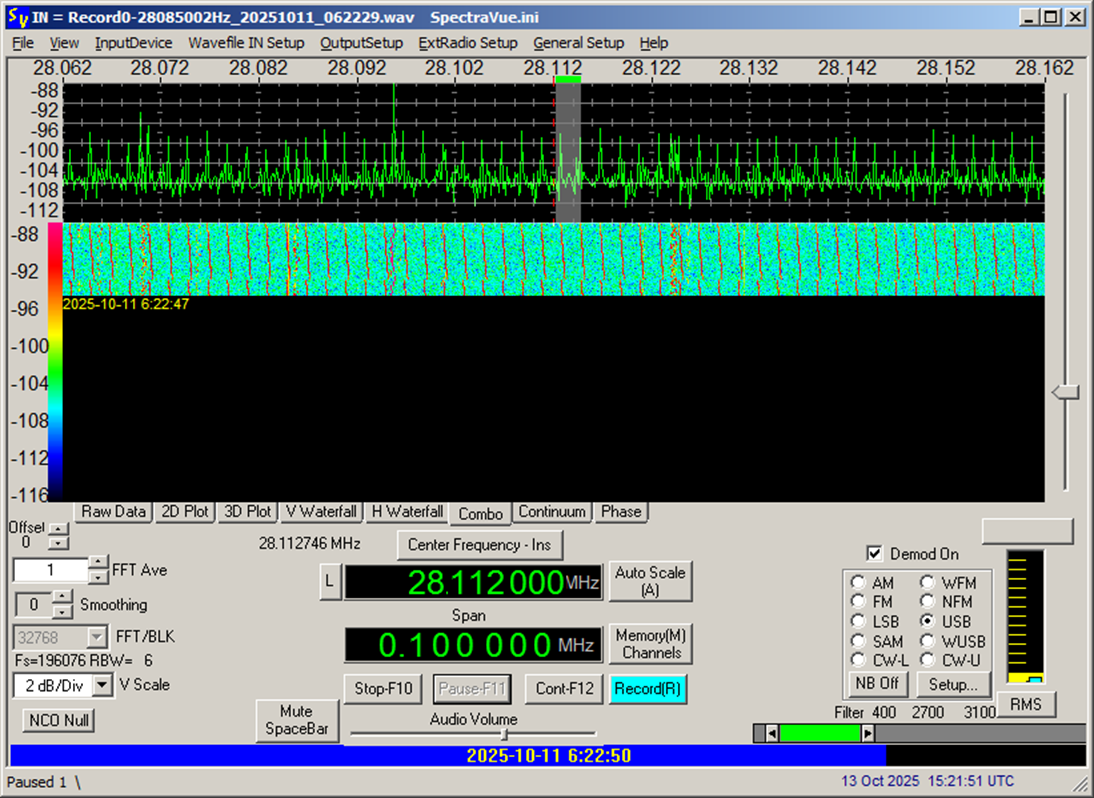 G4RFR Saturday interference
G4RFR Saturday interference
G4RGK Dave
On 16/17 Aug and 13/14 Sept 2025 I was on 13 cm. The 13 cm station is still working as well as can be expected, the stressed reflector profile is not really good enough, but it works!
I was on 13 cm for the two microwave weekends and worked around 15 stations, but I missed quite a few of the CW guys due to time constraints. The weather was calm and that helped immensely as my junk yard mount is not very stable.
On 11 Oct 2025 I spent most of the time on 70 cm. A lot of the time Eu stations were locked out by Faraday. New stations worked on Q65 were: DC1RDB, XQ3SA, GM0ICF, UB4UAA, JO4KVP, BY1QH, NY1V. I have MAP65 running so I can see any CW stations that come up on the bottom of the band but I only saw one amongst the carriers down there, but he was gone when I got there.
On 12 Oct 2025 I was only able to be on 23 cm for long enough to work PY0FBS and attempt a QSO with HL/LY3UM, unfortunately both suffered from heavy QRM from contest stations calling me over the top of the DX-expeditions. This is not Cricket and I will never respond to these calls. I completed with Bruce ok, but not with Alex.
G4YTL David
A quiet month with only great interest being two new DXCC on 23 - HL2/LY3UM and PY0FBS. 3 m mesh dish and 200 watts.
Today (18/10/25) saw no moon noise on 3 cm (1.8 m dish). Problem proved to be a recurrence of a previous problem. Ladybirds in the feed - see photo. I'd previously had the problem with the bugs getting into the waveguide switch, and put Kapton tape across the input. This time the bugs entered the horn and short waveguide section, but of course didn't penetrate the Kapton. Now have Kapton across the mouth of the horn. Should have done that the first time! Slow learner.
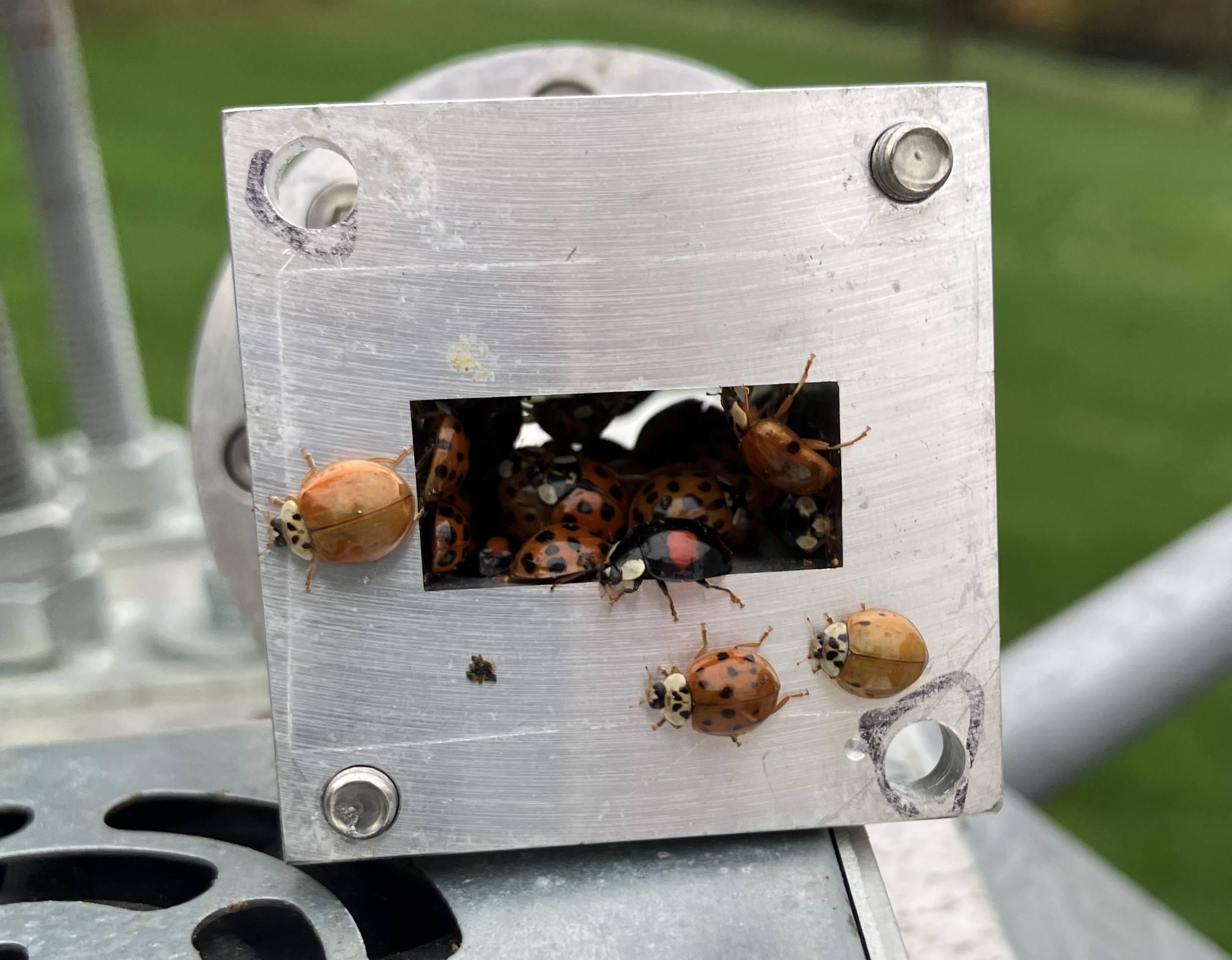 G4YTL ladybird bugs in feed
G4YTL ladybird bugs in feed
HB9Q Dan
The highlight for me is to have worked on 1296 initial #1000 (YL/EA8DBM) on 20 August 2025. The initial #1 was OX2K worked 31 May 2000. It took me 25 years and almost 3 months to work 1000 initials. (Well done Dan, interesting that the #1 and #1000 were both rare DXCCs! Ed)
432: Total initials worked 1357 with 172 DXCC. New initials worked in 2025: K3WM, AG4W, W3TI, W4HFZ, OZ7UV, PC0A, XQ3S, G8XWR, DG1GHY, RY4C, V5/ZS4TX, D2TX, A21TX, OK1IN, PA5BAS, DL8SCQ, DD0VF, F2CT, BG7XWF, VE3CIQ.
1296: Total initials worked 1020 with 151 DXCC. New initials worked in 2025: W6TCP, W8TN, SPØKKM, K6EME, F5KSE, WW2DX, SQ6QV, NØAKC, K3SK, G4RFR, PYØFBS DXCC#151, HL2/EA8DBM, K9ZBU, MØLNB, GW4ZHI, WA4LM, R2BOW, TA1/EA8DBM, ZA/LY3UM, LY3UM, YL/EA8DBM, DL8JJ, NO3M, W4UNU, SP4XD, NØLWF, 3A2EME, MU/EA8DBM, ISØ/HB9COG, I2FAK, MJ/EA8DBM, MD/EA8DBM, HD8G DXCC#150, RY4C, BH6BEZ, DL1HUH, R1MC, WA6RLR, IW4CPU, AC2AC, A71AW DXCC#149, T88UM, KH2/EA8DBM DXCC#148, KHØ/EA8DBM DXCC#147, TX7MAS DXCC#146, PE9GHZ.
23xx: Total initials worked 225 with 73 DXCC. New initials worked in 2025: K5DOG, LY3UM DXCC#73, BA7NQ, YL/EA8DBM, OHØ/EA8DBM, 3A2EME DXCC#72, LA3PNA, PE9GHZ, ZS6JON, ISØ/HB9COG.
3400: Total initials worked 104 with 42 DXCC. QRT since 2024 because band in Switzerland was lost to commercial use.
5760: Total initials worked 116 with 48 DXCC. New initial worked in 2025: IS0/HB9COG DXCC# 48.
10xxx: Total initials worked 248 with 52 DXCC. New initials worked in 2025: SQ9ATC, YO2LAM, PE1MMP, SO5AZ, N2END, SA5IKN, KL6M DXCC#52, NN3Y, OM4XA DXCC#51 , G8RWG, LA4ANA, PE9GHZ, ISØ/HB9COG DXCC#50, VK4WYM.
HL2/LY3UM Alex
Alex LY3UM operated from Korea, October 8th-12th, and worked, on 23 cm, 165 stations with 125 initials including 54 QSOs in the ARRL contest. Sadly 13 cm didn't work.
A very successful dx-pedition once more, overcoming technical problems and dealing with the perils of being very close to the border with North Korea.
More at https://ea8dbm.substack.com/p/hl2ly3um-from-pm37
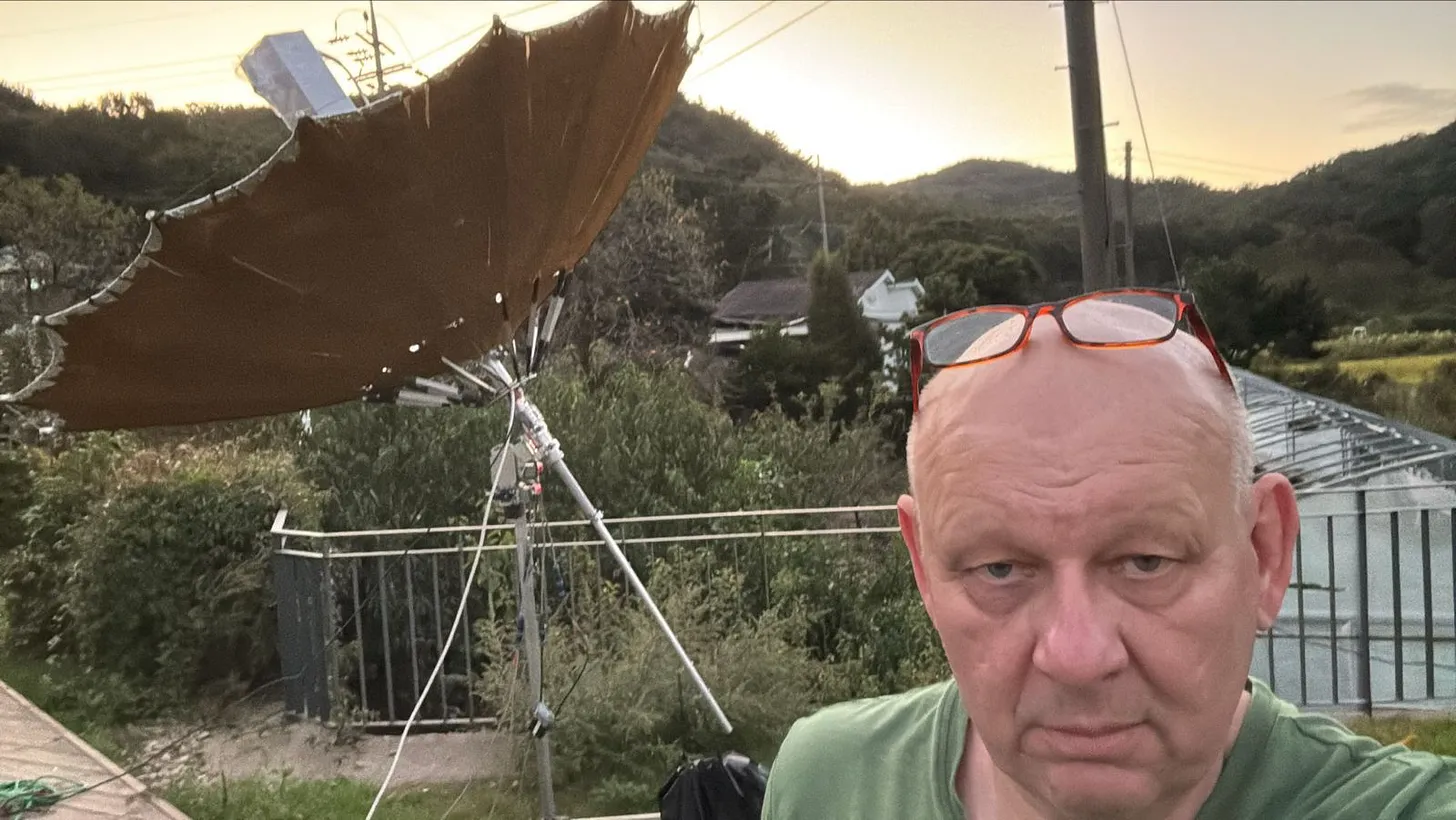 HL2/LY3UM Alex
HL2/LY3UM Alex
I2FAK Franco
In ARRL I didn't operate the entire contest, full first moon pass and 8 hours only into the second day. Total QSOs 81, 65 grids, 10 QSOs in CW.
New stations worked in October: HL2/LY3UM (DXCC # 56), F8DBY, RJ3DC, OZ9KY, SP3YDE, DF7KB, PY0FBS (DXCC # 57), KA1GT, OK1DFC, KA6U, WA3RGQ, W2MMD, K0PTR, ON4LZ, W3IPA, KN0WS, N5BF, OK1KKD, OH1LRY, K4EME, VA7MM, SM6PGP, OK2DL, VK4CDI, SP0KKM, IK1FJI, DK1KW, W3ZS, F5KSE, N0AKC, WW2DX, S05AZ, WA3GFZ, IK3MAC, SM2CEW, LZ2US, F5KUG, IZ1BPN, N4BAA, W8TN (initial #244).
IK1FJI Valter
I was QRV in ARI contest few time, only 8 CW QSO plus one in SSB. No good conditions as sun too close to the moon for weak CW signals.
Worked ZS6CCY for CW initial #180.
In ARRL QRV only Saturday evening/night 21:30 to 00:30 UTC only for fun, no log will be sent.
I had qso with the following fine CW stations: SM5DGX TX 589/RX 599, G4CCH 579/589, G3LTF 579/579, KL6M 579/579, JH5LUZ 569/559 #181 CW, SP3XBO 559/569, I2FAK 559/559 #182, JJ3JHP 569/559, JQ3JWF 559/569 #183, OK2PE 569/589, F5KUG 559/569, SP3YDE 559/539, IK5VLS 559/559.
Out of curiosity I look for digital mode - I agree with Dick PA2DW (comment on moon-net) great confusion - people in Q65 B C, 15 30 60 - also someone with good JT65C! If people are happy that's fine.
Perhaps see you in the second leg, only for make some more QSOs.
3.8 meter dish , 34 db 0.2 NF, TH327 1300 watt @ feed
KA1GT Bob
My main contest interest in October was to see who I could work using Q65-15A. This mode is available in WSJTX v2.8.0-improved and WSJTX v3.0.0-rc1. A complete QSO takes just 90 seconds. By the time of the November contest weekend (and possibly by the time you read this) I expect a general release version 3.x.x may be available, so please update from 2.7.0 if you want to try working Q65-15A. Single period Q0 (no AP) decodes can be expected down to around -20 or -21 dB. With AP in use, Q3 decodes down to -23 dB can be expected. Note that WSJTX 2.7.0 will NOT decode 15A transmissions.
During the contest, using a 3.1 m dish and 240 W, with only 3 or 4 periods of calling CQ for 30 minutes, I worked the following 24 stations: OM4XA, PA0TBR, LA3EQ, W1FKF, IQ2DB, NY1V, UA9FAD, W3IPA, PA3EXV, OK1USW, W3TI, R1NW, K0PRT, AA6I, KB2SA, IZ4VSS, OK1IL, W2LPL, KD5CHG, AC2AC, PE1LWT, DF2VJ, IK7EZN and ES3RF.
The smallest dish I worked was 1 m (KB2SA) and I worked several 1.5 m "cooker" and 2.4 m folding dishes. The 24 QSOs were completed in a total of just 36 minutes. I believe I worked every station that called me. Overall, in the last few months, using Q65-15A I've completed 81 QSOs with 48 different stations, with signal decodes as weak as -22 db. So 15A is not a mode that's available only to large stations. If you've had any QSO where you exchanged signal reports of -20 db or stronger, you could have made it using 15A.
I'm still experimenting with the 1.5 m "cooker" dish and feed (sun noise is now around 10 dB at an SFU of 155 and ground noise 6.5 to 7 dB). With about 200 W at the septum feed, echoes are in the -21/-20 dB region at perigee. I hear echoes in the 1.5 m dish from my 3.1 m dish (240 w) at around -14 dB. QSOs using the 1.5 m dish continue to show that it works very well on 23 cm.
KB7Q Gene
Joyce and I were traveling so I missed the October contest weekend, but I'll push hard in November.
I did get on October 17/18 and work a bunch on 23 cm EME with my 1.5 m "Cooker" dish and 400 watts. I even bagged two new (to me) stations - W8TN -23/-24 and N4BAA -19/-21 to bump my 23cm initials to #232.
Even with degradation hovering around -1.9 other EME friends worked were KD5CHG, OK2AQ, SP5GDM, PA3EXV, N0CTRT, PA3DZL, W2LPL, OH3LWP, W6TCP, DF2VJ, KD5FZX, PH0V, OK1VUM, KH6FA, N5TM, ES3RF, and KA1GT.
It is so nice having a dish that stays mounted full time, and it is quite a surprise to see how well the small dish plays. The best $100 USD a guy could spend. :-)
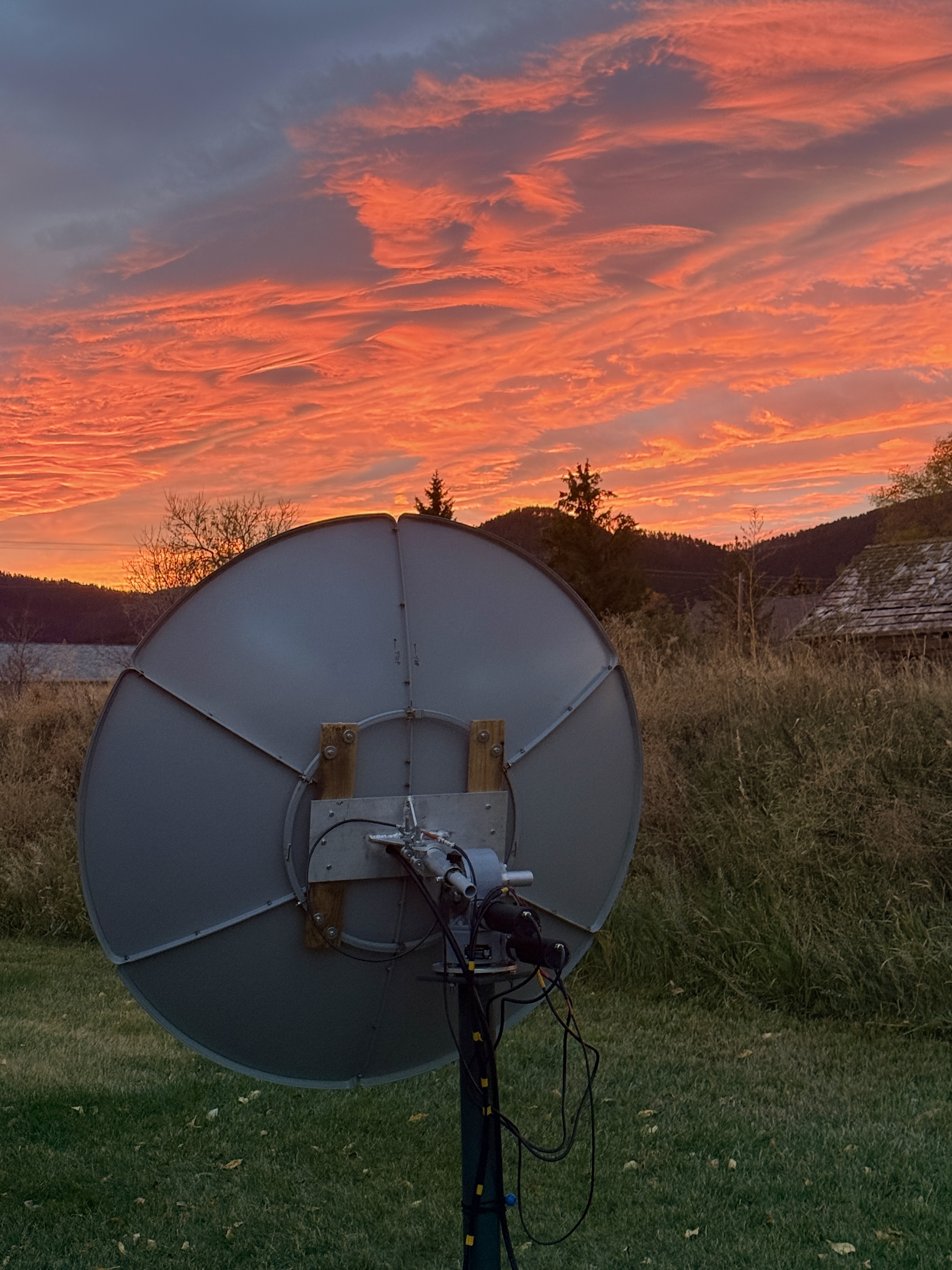 KB7Q the joy of sunrise EME
KB7Q the joy of sunrise EME
KD2XN Phil
Since my last NL submission, these are my current 23 cm Q65 EME stats: 85 QSOs, 79 Initials and 21 DXCC! Working towards my 1st 100 QSOs! Worked 12 23 cm Q65 stations in the month of October as follows:
16 October – SP5GDM (-15/-18), OK2AQ (-23/-22), ON4LX (-21/-23), W6TPC (-17/-21) Initial # 73, WA4LM (-17/-23) Initial #74, KH6FA (-17/-19) Initial #75
17 October – PA3DZL (-10/-13) Initial #76, AA6I (-17/-17) Initial #77, NY1V (-21/-26) Initial #78
18 October – PA0PLY (-17/-18), *KA1GT (-17/-15) Q65-30B Initial #79, I2FAK (-16/-18)
Shout-out to Bob KA1GT – I finally have you in the log! Thanks again for all your guidance as I was building my station. And YES – I will be downloading WSJT-X v 3.0.0-rc1. Q65-15A is my next goal Bob 😊
Downloaded the latest firmware for SPID MD-0X version V2.0.249. Noticed improved Az/El axes motion, especially during final approach. I am now consistently 0.1 degree resolution!
From the mailbox: Received my Dwingeloo PI9RD QSL!
Looking forward to the 2nd leg of the ARRL EME contest. See my QRZ.com page for station info. See you off the moon!
 KD2XN PI9RD QSL card
KD2XN PI9RD QSL card
KN0WS Carl
I went to my northern property for the Fall ARI weekend. I was hoping to test out the pointing of my polar mount, since I had raised one leg of my tripod and re-programmed the encoder for the rotating shaft’s controller box. On 9/20 I started with 70 cm, which I had never done on this 4.8 meter dish in the wake of losing my 6 meter dish. It was terribly disappointing.
After 3-4 hours, I only had one QSO with SM4GGC, I just was hearing nothing! In frustration, I spent several hours changing feeds and gear to 23 cm (not a quick-change). By then the moon was set in Europe. I worked NY1V (15), K6FOD (13), KB2SA (17) on his 1 meter dish, KC2HFQ(15) and W3TI(15). It seemed the dish was pointing OK, so I packed up gear and went home without participating in the second pass.
On 9/23 I dusted off my 9 cm gear and did a sked with K5DOG (17) from my back yard. I don’t usually put in the 5 hours or so to set up and tear down for an individual sked, but for Steve on a new band - of course!
On 10/11 I did 23 cm for the ARRL contest. Moon declination was 28 degrees, but my dish mount only allows declination adjustment up to 25 degrees, so I would be 3 degrees off for the entire weekend. In spite of that, I worked 53 stations, including initials with K9ZBU (10), K6EME (13), HL2/LY3UM (17), OE9ERC (8), R1NW (17), G4RFR (15), OH3LWP (5), OK2AQ (15) and WA4LM (10).
On 10/12 I switched to 70 cm and promptly burned out my Arduino control box for rotation control. In the band change I had reversed polarity of the power lines to that box! Fortunately I had my old analog control box, which I nursed along. Although the new remote cable to change polarity of my feed worked well, the relays inside that feed box did not. It was in retrospect why I had such trouble with 70 cm for ARI. After each TX period, the relays would not re-energize for RX. I would toggle my sequencer on and off 3-10 times until the relay would catch on, but by then I often had lost a RX period entirely.
I worked OK1VUM (15), ON7EQ (21), NC1I (7), KD2LGX (15), SM4GGC (13), DK3WG (8), YL2GD (19), OZ9AAR and had initials with WC8RK (22) and OK1IN (16) before the relay died entirely. So I packed up and drove home to spend the day with my wife. It was our 40th wedding anniversary and she was surprised I came home to spend it with her. (You can see why I married her!) I will try 23 and 70m cm again in November. I have an idea to get me another degree or two of declination and will hopefully have my 70 cm relay issue fixed by then.
N0AKC Charlie
I was not able to get on 432 for the contest due to some RX issues that are still undetermined. However, I had great success on 23 cm logging 71 contacts in 64 grids, 35 of which were new initials. DF7KB, OK1USW, GM0PJC, UN6PD, WA3RGQ, OH3LWP, NY1V, PA3EXV, AC2AC, OH1LRY, R1NW, DL3EBJ, W3IPA, UA1ALD, W3CJK, PA0TBR, DL1SUZ, RX3DR, RD4D, KN2K, DL0SHF, OE9ERC, WA4LM, K9ZBU, DM2CHF, W1FKF, KD5CHG, YL2GD, I2FAK, K4EME, W8TN, W3TI, K6EME, KC2HFQ and HL2/LY3UM, a new DXCC.
I also worked 6 new states: IN, RI, NH, CT, NY, WV. I now have 30 states worked on 23 cm.
I'll only be active again on 23 cm during the first night of the November weekend of the contest as I plan to swap the 902 feed in for the last moon pass. I also hope to have 432 working again.
N4BAA Jose
After more than a year, I am finally on 23 cm EME! First, a very sincere "thank you" to Mike KL6M, who I solicited as my EME Elmer and he has the patience of a saint! THANK YOU! Mike has been great!... AND I am finally QRV.
I have a 3 m dish with septum feed and a 600 watt W6PQL amplifier flowing through LDF7 1 5/8 inch hardline 80 feet to the dish. I am struggling with correct focal distance, but improving everyday. Will be setup for MAP65 this coming week as well.
I have 32 initial QSOs so far and I am hooked! Thanks for everyone's patience as I venture deeper and deeper into the abyss of transforming into a "Lunatic". Hope to see you all off the moon soon! Come get N4BAA in your log!
 N4BAA 23 cm dish
N4BAA 23 cm dish
N5BF Courtney
During the October ARRL EME weekend, worked 51 stations on 23 cm including four on CW. Nine new initials included OK1VUM, PA3EXV, KH6FA, I2FAK, UA1ALD, PA0TBR, R1NW, K9ZBU, and OH3LWP, bringing my total 23 cm initials to 365. This was the first use of the new OK1DFC septum feed on the 2.4 meter folding dish (pictured) which improved it's performance to the level of my previous 3.0 meter dish from years ago (RIP) which was improperly fed initially with what turned out to be too much spillover.
Performance was so good that I put in more time than was planned. Looking forward to the November weekend. It was a great pleasure to meet and have an eyeball QSO with Rafael SP9VFD who was in Tucson, Arizona for the 2025 Microwave Update conference October 17-18. Rafael and I have worked several times on 23 cm EME CW over the years and it was a delight to compare notes and share station pictures in person.
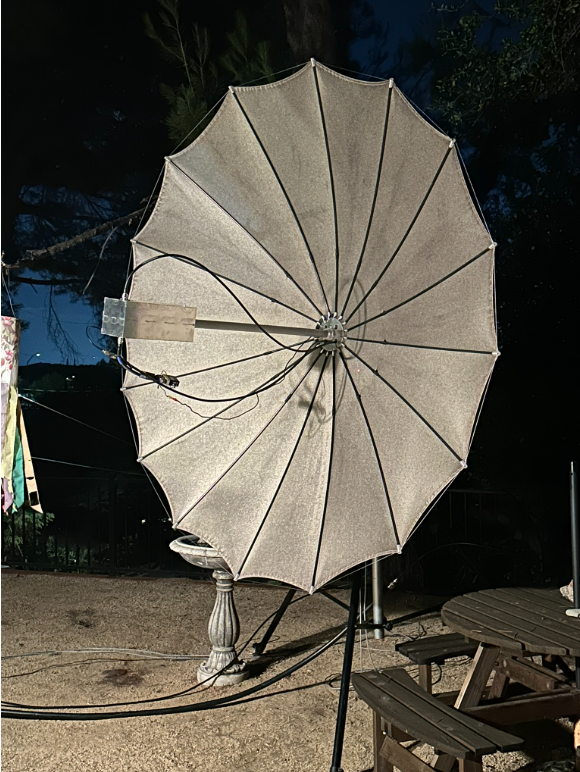 N5BF 2.4 m dish and feed
N5BF 2.4 m dish and feed
NC1I Frank
My activity was limited in October due to conflicts and an amp problem on 70 cm. Thanks to help from K1FMS my 70 cm amp has been repaired. I added the following initials on 70 cm this past month: W4HFZ, G8XWR, W3TI, K3WM, BD1AJF, OM3TRN, VE6BMX, WA8OGS, and BY1QH.
The following 23 cm initials were added: HL2/LY3UM (new DXCC), PY0FBS (new DXCC), W2MMD, and OK1IPV.
Congratulations and thanks to Alex EA8DBM (HL2/LY3UM) and Bruce PY2BS (PY0FBS) for their very successful DXpeditions! Both had excellent and very consistent signals throughout their DXpeditions.
My activity will likely be somewhat limited again in November and December.
OE3JPC Hannes
Worked 23 cm (2x56el YU1CF, 400W):
Aug. 24th KB2SA with his temporary 1 m dish, -23 here!
Contest Oct. 11th/Oct. 12th - I was not too active as I focused on looking for new stations. ES3RF, JJ3JHP, OK1DFC, RD4D (new #197), YO2LAM, DL1SUZ, OK1USW, DL3EBJ, SP3YDE, DK4RC (new #198), PA0TBR, HL2/LY3UM (new #199), DL0SHF, GM0PJD, WA3RGQ, UA9FAD, OH1LRY, F5JWF. hrd W3HZU, no reply
Then, on Oct. 13th, SO5AZ (finally new #200). The LNA "OE3JPC-design" does a good job, no idea about the true noise figure but considering the g/cs and sun/cs ratio the overall system temperature of the 2 yagi-system is pretty low. See https://www.qrz.com/db/OE3JPC
Worked 70 cm (4x24el DJ9BV):
Contest Oct. 11th/Oct. 12th: VK4EME, VK2CMP, DL1VPL, OK1IN, SM4GGC, ON7EQ, KD2LGX, NC1I, DF6LH, DC1RDB, K3WM (new), OK1VUM
OH1LRY Janne
In ARRL EME part 1 we operated 13 cm band on Saturday's Moon pass and did some 3 cm trials on Sunday's moon pass. Eino OH2DG visited at our station on Saturday and operated some QSOs, too. Our 3 cm system is a new unit. PA is 2x15W FLM0910-15F. LNA is DU3T model and system has WR75 waveguide switch. W2IMU style feed horn is illuminating 5.4 m part of 8 m dish. Result was 15 QSOs on 13 cm and 8 QSOs on 3 cm.
ARRL EME part 2 we continued 3 cm on Saturday and changed to 6 cm for Sunday. Result was +14 QSOs on 3 cm and 9 QSOs on 6 cm.
ARRL EME part 3 we were on 23 cm with "QRP" power of only ~50 W as our license is limiting power on 1296 MHz. Result was total 96 QSOs.
ARRL EME part 4 we plan to be on 70 cm.
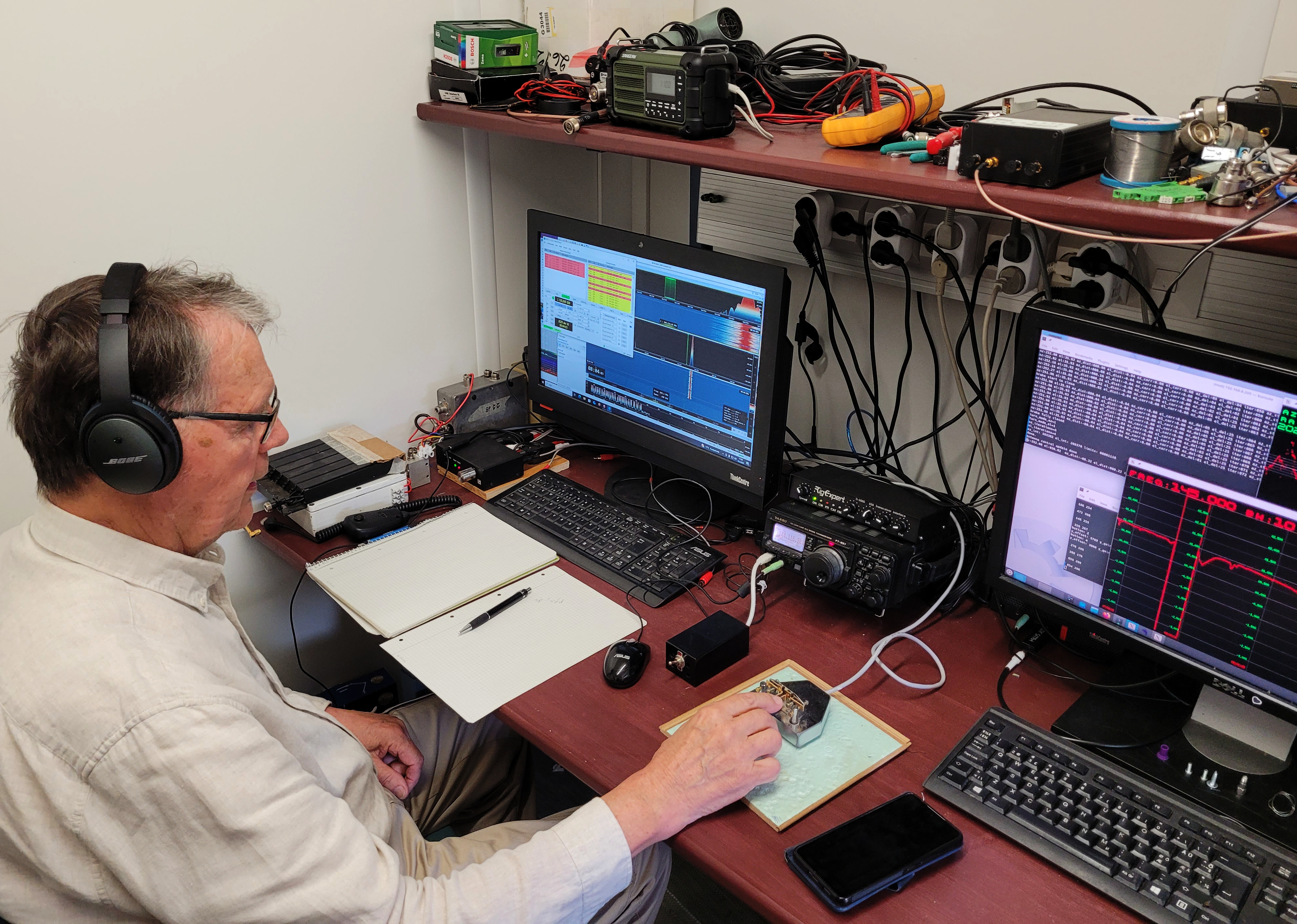 OH1LRY Eino OH2DG op 13 cm
OH1LRY Eino OH2DG op 13 cm
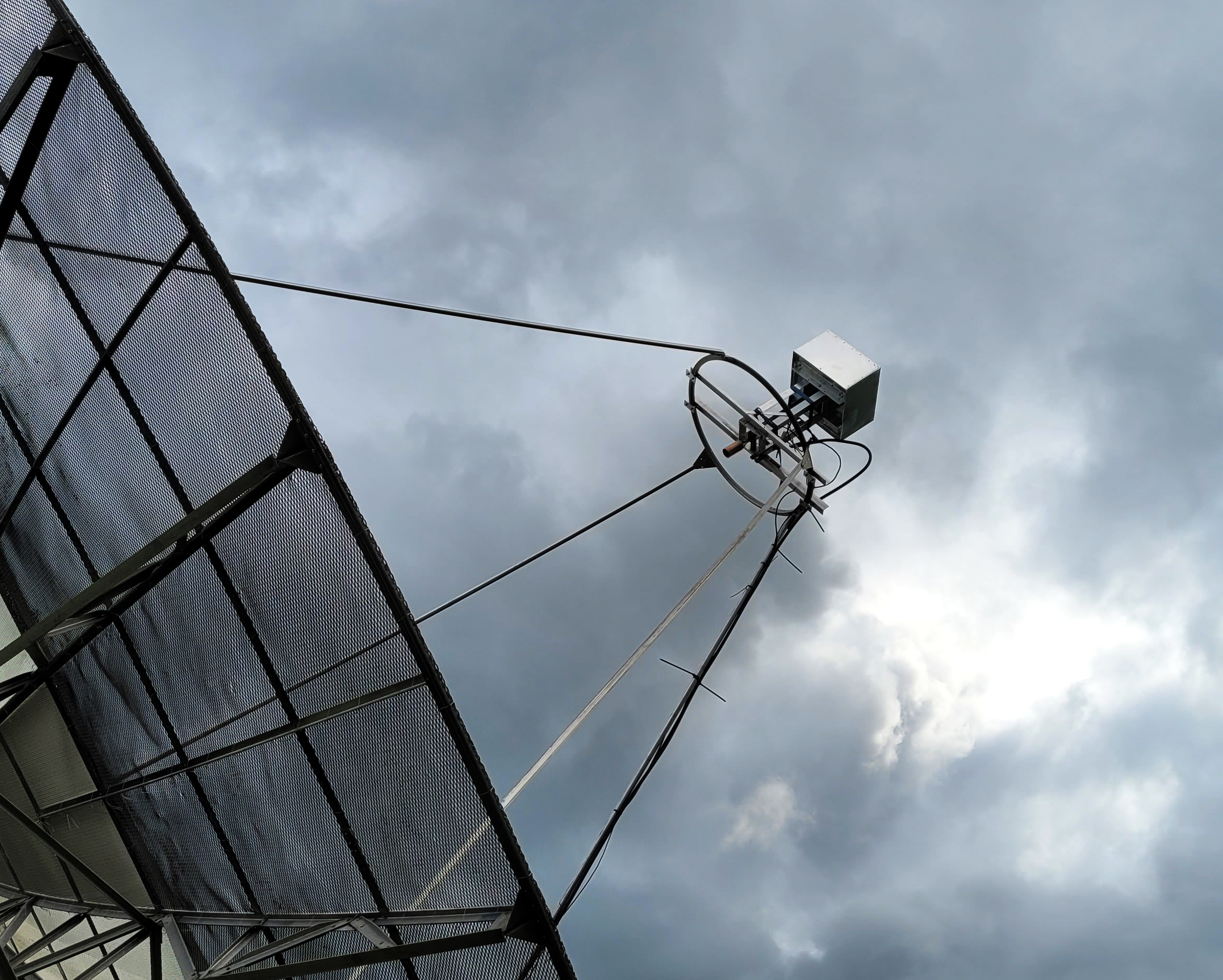 OH1LRY 3 cm system on 8 m dish
OH1LRY 3 cm system on 8 m dish
 OH1LRY 23 cm system on 8 m dish
OH1LRY 23 cm system on 8 m dish
OH3LWP Ari
Activity level was high at 23 cm in the ARRL EME contest 3rd weekend. I was QRV for 16 hours and worked the following at 1.3 GHz:
11/10/2025 digital PY0FBS, K0PRT, SP3YDE, IQ2DB, OK1DFC, R1NW, UA1ALD, N0ACK, OZ9KY, K5N, UA3PTW, OK1USW, WA3RGQ, DF7KB, ON4LX, W1FKF, DL1SUZ, IK2FAK, AC2AC, PA0PLY, OK2DL, W3HZU, KN0WS, IK7EZN, OH1LRY, PA3EXV, OM4XA, N1AV, KB2SA, GM0PJD, KN2K, UA3MRE, K6FOD, G0LBK, WA4LM, OK1KKD, OE9ERC, RD4D, DL0SHF, SP5GDM, DK3WG, OK1UGA, ES3RF, EA2BRI, HB9Q, KH6FA, SM6PGP, VA7MM, W2ZQ, IK2DDR, DL3EBJ, K9ZBU, N5BF, AA6I, W4UNU, PA0TBR, JJ3JHP, HL2/LY3UM, DM2CFH, UA9FAD, VK4CDI, YO2LAM, SM5DGX, DK4RC, OK2AQ, BA7NQ, JQ3JWF, SV1CAL, RJ3DC, GW4ZHI, DK1KW, RX3DR
11/10/2025 CW KL6M, G4CCH, G3LTF
12/10/2025 digital W2LPL, K3SK, LU8ENU, W8TN, IK5VLS, WA3GFZ, W3TI, CT1FFU, W3SZ, KC2HFQ, IU4MES, G4YTL, DG0FE, RA2FGG, VK2JDS, JA4LJB, IZ5TEP
12/10/2025 CW IK3MAC, JH5LUZ, YL2GD
Total of 95 QSOs with a lot of new initials and two new DXCC. Highlights were expeditions to HL2 and PY0. Both were strong with no problem to complete a QSO, thank you for the effort!
Outside ARRL EME contest highlights were nice initial QSOs:
17/10/2025 23 cm digital RD5SAC, W6TCP, DC1RDB
17/10/2025 9 cm CW G3LTF
18/10/2025 13 cm digital ON5QT (Marcel is using yagis)
19/10/2025 3 cm CW IK3MAC
19/10/2025 13 cm CW IW2FZR
OK1DFC Zdenek
Since I managed to achieve a decent result during the microwave part of ARRL in August and September, I decided to try to repeat the result in the Single-operator - Multi-band category this year. In the microwave part, I made 102 QSOs, which was more than in 2024, so I prepared the 23 cm band for the October leg. I didn't have to make any special preparations, everything was tested in the week before the contest when I made a QSO with Alex EA8DBM on his expedition in HL2/LY3UM.
I started on Saturday at 00:00 UTC. The band was very lively from the start. The segment where digital operation takes place was so crowded that there was no place to call CQ, so I used QMAP and called stations across the band. Since almost everyone has learned to use Q65-30B in the contest, the operation was fast and without delays in queues. The speed of operation was at the level of operation when there are enough stations, as in CW. However, this was not the case during this contest. The CW segment was empty.
On the contrary, a lot of new stations from the USA appeared in the digital part, and I must say that I have not experienced such activity for a long time. Apparently, the sufficient number of "umbrella" antennas from W2HRO and 150 manufactured septum feeds for the 23 cm band did their job. I was really not bored, and there were moments when I didn't even have time for coffee, which was a big change from previous years.
Overall, I managed to make 143 valid QSOs, of which 130 QSOs were Q65 and only 13 QSOs were CW. In total, I have 117 squares - multipliers for the first round. I managed to connect with 16 JT new initials. A highlight was the connection with the exotic island of Fernando de Noronha, where Bruce PY2BS was QRV as PY0FBS #145 DXCC.
I have 1,673,100 points for the first round, which, together with the result in the microwave section, gives me hope for a decent placement. In November, I will be participating in the second round, where I will be QRV in the 432 MHz band and also occasionally in the 23 cm band. Let's hope the weather will be good. I wish everyone many nice connections in the second round and hope to hear you on the air. OK and OM stations did not get lost in the first round and there will definitely be something to do in November as well. Finally, I am not listing the entire log, but only the new initials.
11-10-2005 PY0FBS DXCC#145, I2FAK, R1NW, G4RFR, SP0KKM, K9ZBU, GW4ZHI, WA4LM, M0LNB, R1MC
12-10-2025 OK1IPV, F5KSE, W8TN, SO5AZ, K6EME, CT1FFU
OK1KIR Vlada
My report covers September and October activity.
Early in September we were concentrated on the 23 cm expedition of Alex, EA8DBM to Albania and Turkey. While being on QRX on 23 cm we worked on 5th Sept with Q65-30B at 19:21 YU1DA as #635 and then at 19:32 ZA/YL3UM with good signal (-13/-12) as 1st ZA/OK 23 cm QSO and #636. Later on 9th Sept we worked on 23 cm Alex as TA1/EA8DBM at 19:44 as #637.
In the second weekend of ARRL EME Contest we made 6 new CW stations when KN0WS was new #203 and with Q65-60C we added 10 new stations when KN2K was new #120. On Sunday we found unfortunately only two new stations, so we went QRT far before our MS.
It was a shame that Alex in ZA was QRV only on 23 cm being unable to get on the air for a failure on his 13 cm rig.
In ARRL EME Contest we overall completed on 13 cm together in the both weekends 34 QSOs with 32 multipliers in the multioperator all mode single band category.
We plan to be active in the remaining weekends of ARRL EME Contest but mainly focused on searching new stations.
We participated in the autumn part of ARI EME Contest during Moon pass on Saturday. We were QRV on 3 cm band looking for new stations. On Sept 20th we made only 5 CW QSO due to high spread of signals reaching almost about 200 Hz. With Q65-60D we added 16 QSOs and even with Q65-60E we worked G4HSK. As new initials we made YO2LAM #278, PA0JCA #279 and SO5AZ as #280. Sun noise was measured 18 dB and Moon noise 2.6 dB at 12 UT. On Sunday Sept 21st not one new initial was found on HB9Q logger.
The October week EME activity close to ARRL contest 2025.
Announced 23 cm and potentially 13 cm expedition of Alex EA8DBM from South Korea pumped us up to install 23 cm in advance already on Mon, Oct 6th. It was a brilliant idea because the final obvious short key down TX test suddenly created a strange sound inside SSPA and initiated protection circuits.
After disassembly we found dirty place on PCB and missing evaporated small SMD 22pF capacitor (too small or improper quality) in the output circuit of one from 4 combined PE1RKI SSPAs. A similar failure appeared only during initial operation sometime in 2016. Must note that our 23 cm SSPAs unfortunately came from the initial PE1RKI design with probably a bit underestimated small ATC capacitors and too thin copper striplines on the outputs. Therefore SSPA requires huge air cooling of the otherwise massive AL heatsinks. Next day the layout was repaired and the eve TX test was OK. Quite tough, but fortunately we did catch it up before the expedition.
Next day, Oct 8th, at our MR, having only 3 deg of elevation with a lot of ground noise we decoded Alex’s CQ and worked him at 17:13 as HL2/LY3UM (-14/-8) as digi #638 and 1st OK-HL 23 cm. Later in the night Alex assigned 13 cm test on Thu, Oct 9th Moonpass. We swapped on Oct 9th to 13 cm, but due to windy and rainy WX Alex moved the 13 cm test to Fri, Oct 10th. So, we reinstalled 23 cm and shortly after MR at Bruce expedition we worked him at 23:27 as PY0FBS (-14/-10) as digi #644 and 1st OK-PY0F 23 cm QSO. On Fri, Oct 10th Alex reported failure on his 13 cm TX, so 13 cm test from HL was gone.
We closed several days demanding operation and decided to take part in ARRL Contest just during the weekend’s Moonpass Oct 11th/12th on 23 cm.
In short, overall result of the weekend operation brought 13 new digi initials and 5 CW initials on 23 cm. Among them HL (#525 on Oct 11th at 20:11 O/O) and PY0F (#529 on Oct 13th at 06:31 O/O) were new CW DXCC.
Digi QSOs during the ARRL Contest were mixed Q65-30B and/or 60C modes. There appeared a problem that some stations used a so called contest mode and did not send the report. However, current practices say that without exchanging the calls, reports and R’s the QSO cannot be counted as the initial (e.g. scoring summaries of DF6NA etc.).
On our side such case was e.g. QSO with K5N. That issue raised an extensive discussion among EME community after the ARRL Contest. We are now watching it and waiting for a final decision, if any.
OK1VUM Mila
In this year's ARRL EME contest I chose the 70 cm band, where I have better equipment than on 23 cm. I started right at 0:00 UTC and at the beginning I called stations that were calling CQ, which was enough for the first hour. Although I usually got through on the first try, it was still boring because the digital EME contact procedure is desperately slow. This time there was a problem with the logger, which had very long response times and was unusable for communication. The fix came only at the end of the contest. I relied on QMAP, but it always crashed after a short time. I didn't feel like restarting it all the time, so I decided to forget about it and just rely on calling CQ like in the old days.
Later, complaints about QMAP crashes appeared on MoonNet, so I wasn't alone in this, it looks like the author has his work cut out for him I couldn't stay awake during the second orbit. First, I overslept the start and didn't begin until 23:30 then I went to sleep at around 03:00. It probably didn't matter too much, because Faraday rotation made QSOs across Europe almost impossible and there were few American stations on the band. The last section went better than expected, with Europe, Asia, and Australia coming through beautifully. Stations from China were a surprise, with BY1QH, BH2RSJ, BG7XWF, and BA7LVG all coming through. They were mostly using bare radios without PA, so only about 50 W.
Then there was Taiwan BV3CE and Chile XQ3SA, from whom I have a screenshot showing, among other things, the connection with me. Guillermo obviously does not have a stable frequency, because his signal was twisted like a question mark. I also worked Michal OM3TRN, with his big 16 yagi array. Other OK stations in the log are OK1IN, OK1JG, and OK1TEH.
I worked 7 initials: XQ3SA, YO2NAA, BH2RSJ, F6DRO, BA7LVG, BG7XWF and OK1TEH
The total number of contacts, 68, is slightly below expectations. The reason is low participation; there was nothing to do for long periods of time. The smallest station I worked used a 9-element antenna and 50 W. Everyone who uses UHF has such hardware at home, so why not try it in the second part in November.
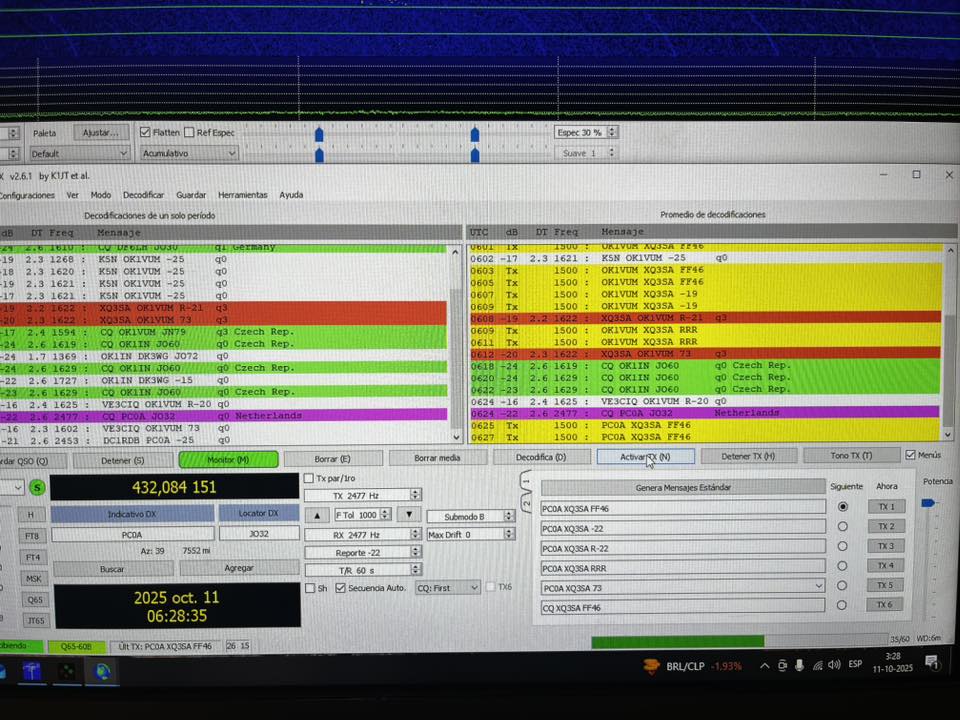 OK1VUM XQ3SA WSJT
OK1VUM XQ3SA WSJT
OK2AQ Mirek
In second half of August, I had 23 cm installed and was monitoring the initials. Alex was doing great this time, so I continue to work with him as YL/EA8DBM, and LY3UM. In addition, I had initial QSOs with EA2BRI, W1FKF, GW4ZHI, OE5JFL, W3TI, and DL3EBJ. Then we had to go to Brno for a few days, so I barely caught Alex from Turkey as TA1/EA8DBM. Alex returned to ZA, so I planned to do him on Friday night and install 3 cm on Saturday. Unfortunately, Alex had an antenna malfunction on Friday, so we missed each other.
Leg II of the ARRL Contest on 3 cm took place in rainy weather, but without wind and with decent participation. I made 14 QSOs with the initials VK4WYM and IK3GHY. In total, I have 42 QSOs with 40 multipliers on 10 GHz in both legs (168 000 points).
The autumn part of the A.R.I. EME contest on 3 cm took place in beautiful summer weather, albeit windy. The Moon was above the horizon from early morning until afternoon, which was pleasant. The price for this, however, was the proximity of the sun. On both days, there was also a large spread of over 200 Hz. This made it difficult to connect with small stations (˜dish 1 m, 10 W). Overall participation was good, especially from Europe. The other continents were represented by K5DOG, CX2SC, and VK7ZBX, along with VK4WYM. I made a total of 28 QSOs, three of which were CW OK1KIR, OZ1LPR, and IK0HWJ. The only initial was PA0JCA.
At the beginning of October, I had 23 cm in focus again and was waiting for Alex from HL. Before that, I made the initial IZ4VSS and then smoothly HL2/LY3UM (-24/-26). This was followed by the initials RJ3DC, OH1LRY, and OZ9KY. In the ARRL contest, I intend to compete only in the 3 cm band, so for me, the weekend contest in the 23 cm band was primarily a relaxed opportunity to collect new initials.
The very first QSO was with Bruce PY0FBS, again smoothly (-27/-23), followed by KN0WS, R1NW, K0PRT, K5N, SV1CAL DXCC 58, W3IPA, W8TN, OK1KKD, and K9ZBU {#250}. The Q65-30B mode was used extensively in the contest, which significantly sped up traffic for "large" stations. On the other hand, it was counterproductive for "small" stations communicating with each other, requiring repetition of messages. Overall, I made 29 QSOs in the contest. On-line log: https://www.radio.feec.vutbr.cz/esl/files/EME/LOG/EME_LOG_10G.htm
The pages can be switched between bands using the buttons at the bottom left.
WILEY Publishing has released my book Reception of Weak Radio Signals from Space. It is a translation of the book Slabé signály, which was published by VUTIUM in Czech in 2023. Attached is a pdf of the hardcover and the table of contents.
You can order the book here https://www.wiley.com/en-ie/Reception+of+Weak+Radio+Signals+from+Space-p-9781394292745
 OK2AQ Reception of Weak Radio Signals from Space front cover
OK2AQ Reception of Weak Radio Signals from Space front cover
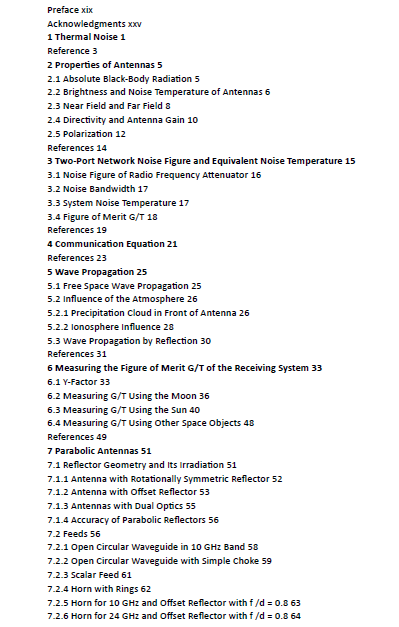 OK2AQ Reception of Weak Radio Signals from Space table of contents
OK2AQ Reception of Weak Radio Signals from Space table of contents
ON5QT Marcel
Reported by PA3DZL: Marcel made his first ever QSO on 13 cm with PA3DZL. ON5QT is running 4 x 44el Yagis and 150 W. He also worked OH3LWP for his 2nd initial.
 ON5QT antennas
ON5QT antennas
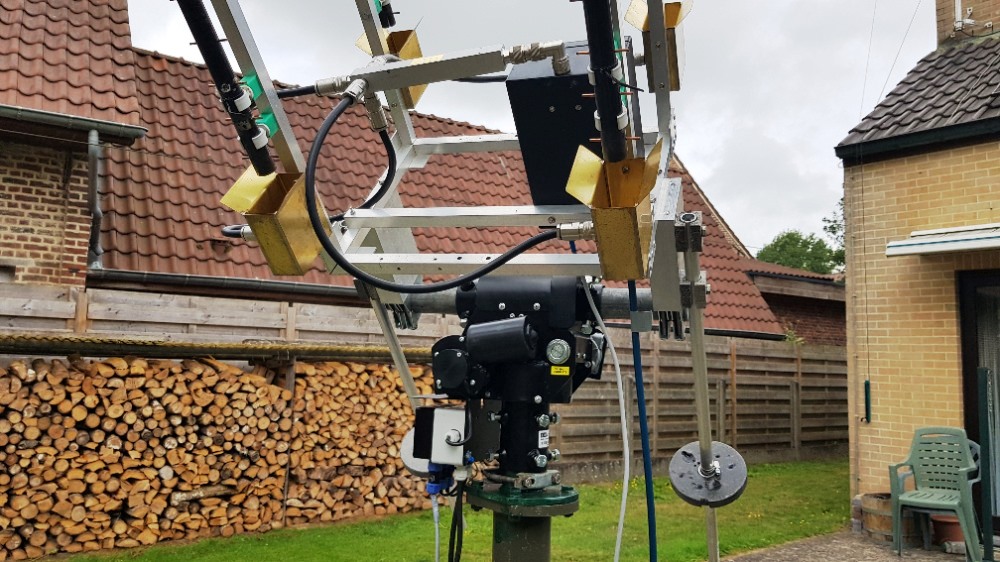 ON5QT AZ EL
ON5QT AZ EL
ON5TA Eric
Very nice activity on 10 GHz during the ARRL contest! I ended with a total of 53 distinct stations CW/Q65 over the 2 weekends, despite the dish being obstructed in many directions by houses and trees. I estimate that 65 to 70 stations could have participated over the 2 legs. Conditions were good, with small stations putting up very respectable signals, such as Max SA5IKN/P, who was very busy with his 90 cm dish. I had another nice QSO with Chuck NJ6D who was running just 10 W into a 76 cm dish. I was also most happy to QSO Mike KL6M, init. and 1st ON-KL. Mike had an excellent signal (-9) with his large dish!
I spent a few hours on 10 GHz in the September session of the ARI contest. Spread was very wide, Moon near apogee and close to the sun. Made 18 QSOs, among them SA5IKN (90 cm dish) and IZ2DJP (1 m, 12 W), both very easy to contact despite the far from optimum conditions at that time.
On Oct 12, had a nice QSO with Robert LA4ANA who was running 10 W, a 90 cm dish, all coax and a dual-band QO-100 feed with a dielectric lens.
Experience shows that, when conditions are reasonably good, small stations can be quite easily contacted IF they are able to track the Moon accurately. This seems to be the key to success on 3 cm! A way to measure small Moon noise variations is very desirable and can be done with a noise meter or an SDR. Another alternative may be to carefully peak the dish on DL0SHF, which is now back on air (Many thanks to Per DK7LJ for all his efforts !)
PA0TBR Ton
I operate on 23 cm with Q65 using a 3.5 m dish with 400 – 500 W in the feed.
In July I had a pleasant surprise when I heard and worked KH6FA for a new DXCC and initial. I mentioned before that I have a giant tree to the west but just before moonset I have a tiny gap that enables me to make a QSO when the moon is just in the right place. This gap was enough to contact KH6FA.
Alex, EA8DBM, was again very active with another trip in August and September to give us some new places. I was able to work him again as OH0/EA8DBM, YL/EA8DBM, LY4UM and for 2 new DXCCs as ZA/LY3UM and TA1/EA8DBM. Many thanks Alex for all your hard work to give us so many DXCCs!
I was active during the ARI Autumn EME contest. Unfortunately the sun played havoc with us on Sunday with a very close proximity to the moon.
I worked 22 stations on Saturday and 7 on Sunday, giving a total of 29 including 6 Italian stations. Activity and score was low compared to the Spring contest, but I could not complain at all with GW4ZHI as a new DXCC and 3 more new initials: YU1DA, JH3AZC and DJ3JJ.
October brought another surprise from Alex, EA8DBM when he activated HL2/LY3UM, a new DXCC for me and I am sure for many others. I was able to contact Alex before and during the ARRL EME contest. Excellent work Alex!
Also the excellent DXpedition of Bruce, PY2BS to activate Fernando de Noronha didn’t go unnoticed. Thank you so much Bruce!
The ARRL EME contest was great fun again. It were 2 long days with operation during the night. The high elevation enabled me to continue towards the west and also the moonset with an Az of 316 deg was also very helpful. It resulted in 81 QSOs with PY0FBS and KL6M for 2 new DXCCs and 20 new initials. I see that I have missed many stations during the contest, so I should have plenty to catch during the next leg in the weekend of 8 November.
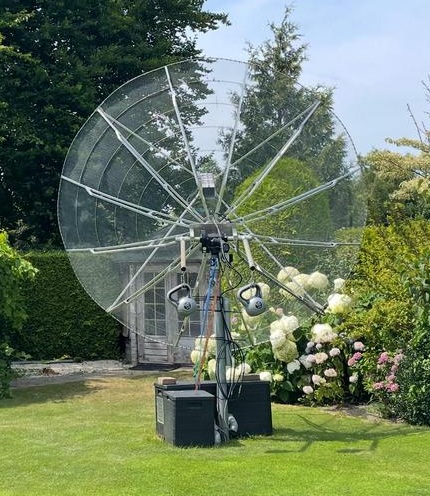 PA0TBR dish
PA0TBR dish
PA0PLY Jan
Here are my results of the ARRL contest on 1296 MHz, I made a total of 54 QSOs and 10 initials, actually I was hunting for new initials. I spent the first moonpass covering the western section as my elevation actuator has a max range of 60 degrees.
I see more and more US based stations using the 2.4 m dish and some 200 W which actually generates a good signal on 23 cm.
On the second moonpass I looked for new stations during our moonrise. Only 2 JA statons were worked.
Initials were: PY0FBS (-20/-19), W3IPA (-12/-17), W3HZU (-20/R), F5JFW (-13/-12), EA2BRI (-12/-18), PA2GWA (-21/-23), W4UNU (-17/-22), UA3MRE (-13/-12), M0LNB (-21/-23) and SP0KKM (-17/-26)
No spookie things here during these moonpasses, only QMAP refused to decode, after installing the latest version of WSJTx, it worked again.
(Initially I was using a time limited WSJT-x version and it was outdated )
After the contest I worked: 16 October: W6TCP ( -12/-13), W2LPL (-16/-19), WA4LM ( -13/-18) and on 18 October DC1RCB (-20/-18), N4BAA (-13/-16), KD2XN (-18/-17), 9H1BN (-18/-17), PA3ESH (-18/-22), IU4MES (-19/-24) and W8TN (-17/-17)
The next ARRL event I will be active on 432 MHz.
I spent some more time at PI9RD and installed the RF power indicators for 9 cm and 13 cm. Both frequencies are now ready and available on request.
Also we installed a 2.4 m PF dish, which initially will be used for H-line detection, but the second idea is to use it for 10 GHz. See attached picture.
Regarding the development of products for 10 GHz, we received an overwhelming response for the 10 GHz SSPA. As for now Ron, DU3T plans to have the pilot unit ready at the beginning of 2026. Most likely we will show it during the HEELWEG-2026 Meeting in January.
Last but not least; Let me remind everyone that we have a single band 13 cm Event on December 6th and 7th moonpasses. DU3T and most likely PI9RD will be active then.
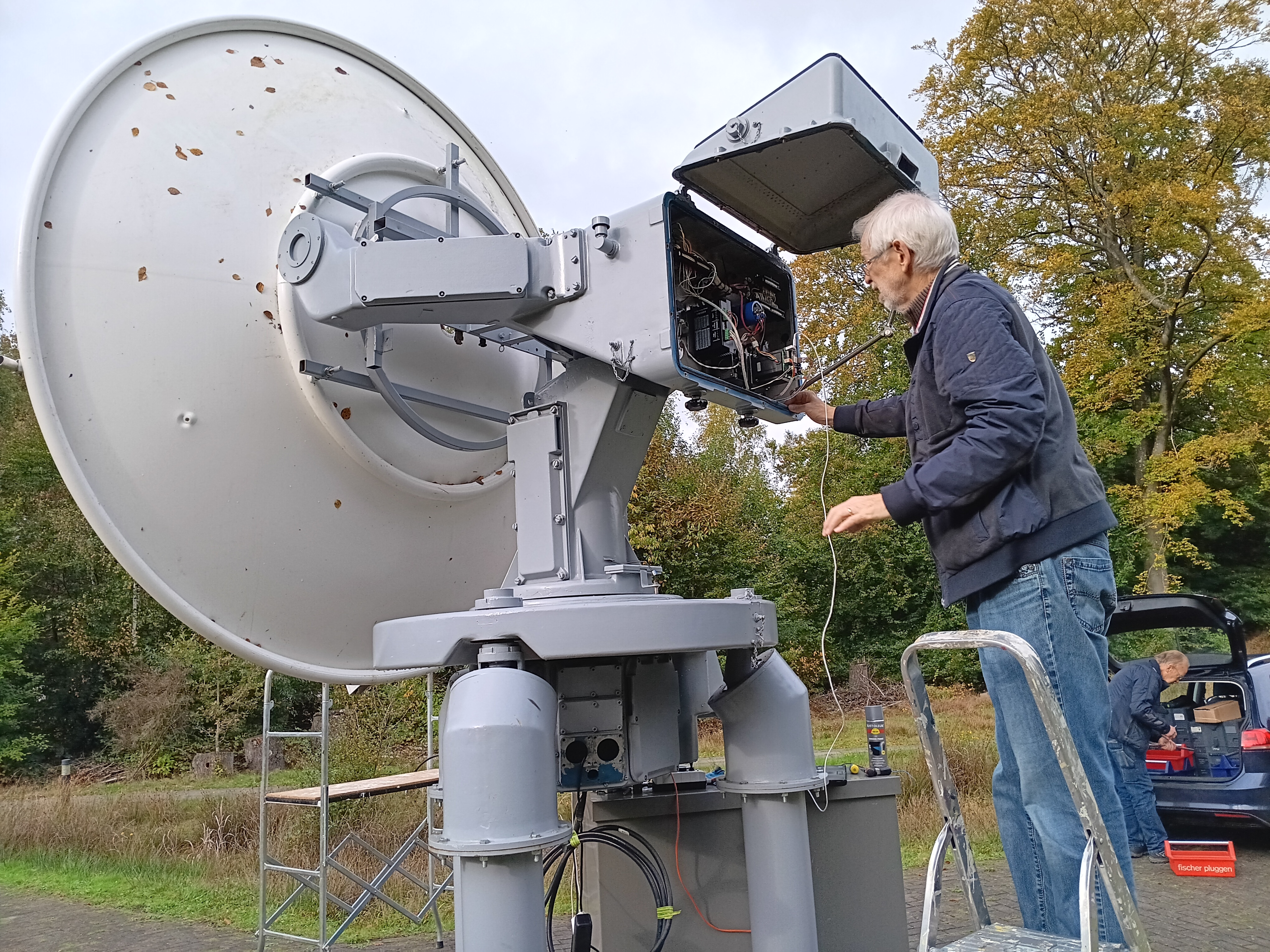 PI9RD 240 cm dish
PI9RD 240 cm dish
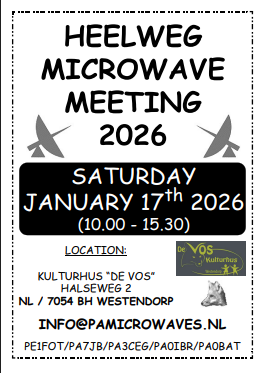 Heelweg 2026 meeting notice
Heelweg 2026 meeting notice
PA3DZL Jac
On 432 MHz very nice activity and initials, worked: GM8JBJ #, CT7ABA #, GØJDL, IZ3ATX #, SQ2SAT, OM3TRN #, DL8DAU, OK1JG, OK1IN, GDØTEP, DK3WG, SM4GGC, OZ7UV # and XQ3SA # and also new DXCC #86
On 1296MHz nice activity and initials, worked: VK2JDS, JA4UMN #, OK2AQ, GMØPJD, 9H1BN, PHØV, PE1LWT, F8DBY, UA1ALD, HL2/LY3UM # and DXCC #119, GW4ZHI #, PYØFBS # and DXCC #120, OK1DFC, I2FAK, DL3EBJ, YO2LAM, RD4D, K3SK, SO5AZ #, ON4LX, PA3HDG, NC1I, KB2SA, LU8ENU, N5BF, G3LTF, KL6M, F5KUG, K9ZBU #, W3HZU, W3IPA #, KD2XN #, W6TCP, DC1RDB #, NØCTR, W2LPL and KB7Q
During the ARRL contest I was only QRV on Sunday for some hours, made 20 QSOs on 1296 MHz also 20 QSOs on 144 MHz. I had a company event on Saturday so no Radio.
On 2320 Mhz I worked ON5QT # Marcel, for his FIRST QSO ever on 13 cm. ON5QT is running 4 x 44el. Yagis and 150 W. Marcel also wkd OH3LWP for his 2nd initial. I also worked OH3LWP with a massive signal.
PY0FBS - Bruce PY2BS
Following the results of HD8G DXped, Fernando de Noronha emerged as the next logical destination. Mário PY2DV, also participating on HD8G Dxped, bought the idea, and so we teamed up, him as PY0FB and active on HF + 6 m.
Fernando de Noronha is one of only three Brazilian oceanic islands recognized for DXCC, and uniquely one that is a tourism destination and readily accessible. The two others — Trindade and Martim Vaz (PY0T), and Saint Peter and Saint Paul (PY0S) have little or no support, and require special permits that are difficult or even impossible, to obtain.
The location chosen was on the northern tip of the Island, know as Air France’s tip. That’s because the airline had established there a communication and support building by late 20s, initially for the flying boats carrying mail to Brazil. The island was also used by the US during WWII which built up the original aviation strip there.
An unanticipated challenge on FN was the wind. Despite the previous experience on the similarly sea-facing Galápagos islands, where wind was not an issue, Fernando de Noronha proved entirely different. Last minute pre-departure research indicated prevailing E/SE winds, so it was assumed that the antenna location on the opposite side of the house it would be sheltered. We were mistaken. The wind at the planned site was so strong it threatened to destroy the reflector, jeopardizing the entire operation and rendering the trip a failure.
After a frantic search, we discovered a very unlikely solution: a spot near the corner of the house, immediately adjacent to the main strong wind stream, which was remarkably protected. We had to change the station location as the set of cables wasn't long enough for the revised antenna spot, but the dish survived perfectly. As a safety precaution, it was stowed when not in use.
Used the same SSPA from HD8G, running at 200 W. Despite the relatively low power, the results were very good - 160 QSOs with 127 different stations from 32 countries, with two CW QSOs near the end of activity, after rush installing CW type SW, as no keyer around.
So it ended up well, let’s see what comes next, possibly some new location for 2026? Stations worked during the DXpedition to Fernando de Noronha:
9H1BN, AA6I, AC2AC, BA7NQ, CT1FFU, CT1WO, DF2VJ, DF3RU, DF7KB, DG0FE, DG5CST, DJ2DY, DJ3JJ, DJ7FJ, DK3WG, DK4RC, DK5AI, DL0SHF, DL1HUH, DL1SUZ, DL3EBJ, DL4DTU, DL7UDA, DL8FBD, DM2CFH, EA8DBM, ES3RF, F5JWF, F5KUG, G0LBK, G3LTF, G4CCH, G4RFR, G4RGK, G4YTL, GM0PJD, GW4ZHI, HB9Q, I2FAK, IK2CDI, IK2DDR, IK3COJ, IK5VLS, IK7EZN, IQ2DB, IZ8GGF, JA4LJB, JA6AHB, JH3AZC, JJ3JHP, JQ3JWF, K0PRT, K3SK, K5N, K6EME, K6FOD, KA1GT, KB2SA, KD5CHG, KL6M, KN0WS, LA3EQ, LZ4OC, N0CTR, N1AV, N5TM, NC1I, NY1V, OE9ERC, OH1LRY, OH3LWP, OK1DFC, OK1IL, OK1KIR, OK1KKD, OK1UGA, OK1USW, OK1VUM, OK2AQ, OK2DL, OM4XA, ON4AOI, ON4MU, ON5GS, PA0BAT, PA0PLY, PA0TBR, PA2DW, PA3DZL, PA3EXV, PA3FXB, PA3HDG, PA7JB, PE1L, PE1LWT, R1NW, RA4HL, RD4D, RW6HM, RX3DR, RX6AIA, SA6BUN, SM5DGX, SM6CKU, SM6PGP, SP3XBO, SP3YDE, SP5GDM, SP7EXY, UA3MRE, UA3PTW, UA9FAD, UA9YLU, UN6PD, VA7MM, VE6TA, W1FKF, W2HRO, W2ZQ, W3IPA, W3TI, W5LUA, YL2GD, YO2LAM, ZS4TX, ZS5Y, ZS6JON.
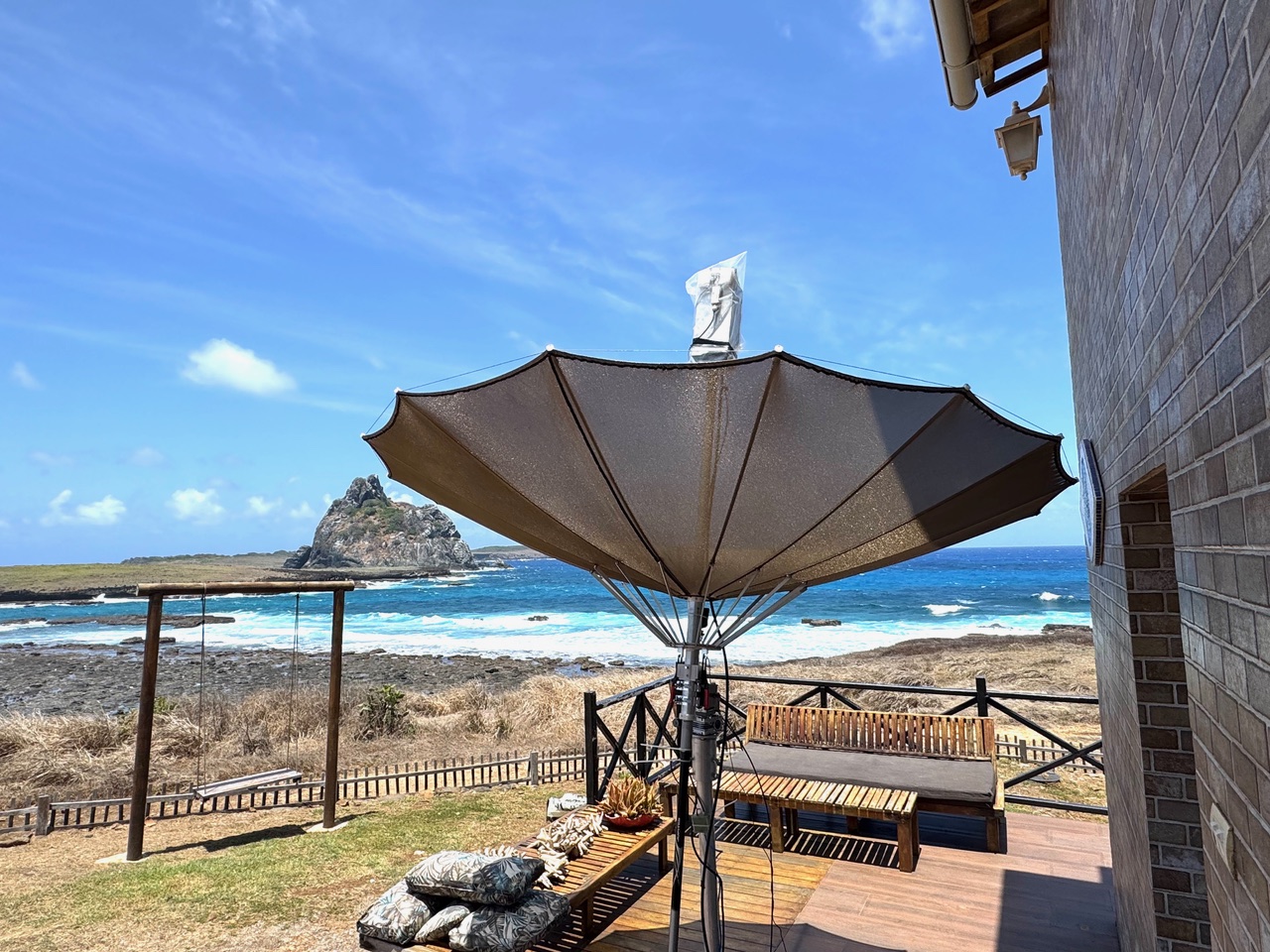 PY0FBS portable dish
PY0FBS portable dish
 PY0FBS station setup
PY0FBS station setup
SA5IKN Max
As the weather predictably worsened in Sweden during October, my portable 10 GHz EME activity was limited to one portable operation and another session from home, mainly focused on polarization tests.
The only new initial this month with my 0.9 m dish and 27 W was John PA7JB. Other QSOs were made with Mike KM0T, Bert DL4DTU, Julian and Rob at G4RFR, Gino IK0HWJ, Bata YO2LAM, Ari OH3LWP, and Peter OZ1LPR. This is significantly down from the 72 QSOs made with my portable EME system last month. I also spent some time trying with Ric CX2SC, who made a great effort to be QRV early in the morning, but very high Doppler spreading and large moon distance on the day of our attempt were not in our favour.
On the software side, EME Observer planner and station map received an update with real-time tracking mode and improved station filtering, and the new yearly moon ephemeris is now available on EME.radio (thanks to Bob W1QA and Peter G3LTF).
 SA5IKN portable 10 GHZ EME station
SA5IKN portable 10 GHZ EME station
SM2CEW Peter
On 18 September I was on briefly for the 23 cm for the ARI contest in CW and worked G3LTF, OK2PE, G4CCH, IK5VLS, G0LBK and IQ2DB. Not as high activity as I had hoped for but glad to make some random QSOs with good friends. On the weekend 11-12 October I was again on 23 cm and worked the following stations in CW, random only: G3LTF, LZ2US, KL6M, IK3COJ, F5KUG, SP6JLW, WA6PY, IK3MAC, OK1KKD, G4CCH, SP3XBO, SV3AAF, W2ZQ #, DL0SHF, WB8HRW #, I2FAK #, DG5CST and VA7MM. Many of these stations were really loud, good to see fine EME conditions despite very strong geomagnetic disturbance here at latitude 65.4N. Unfortunately strong winds prevented me from spending more time on the moon.
Rig 8 m dish, HB YL1057 amplifier plus a long feedline to the W2IMU feedhorn. The plan is to be QRV in CW on both 70 cm and 23 cm in November.
VE4MA Barry
There was no 47 GHz EME activity for me in October as the focus of many stations was the 76 GHz EME tests with RW3BP. I had planned to be QRV on 432 MHz early on Saturday October 12 but domestic issues delayed my getting configured for it until the next day.
I am using my 3 m dish with a W5LUA / PY2BS dual polarity patch feed and 300 W. As is typical for small dishes on 432, the feed had to be located a multiple of a half wavelength from the vertex of the dish in order to get a good VSWR. I have not checked sun noise recently but it does work like 4 yagis with polarity switching.
I did QSO NC1I (-13/-13), OK1VUM (-14/-18), DK3WG (-15/-20), DL1VPL (-17/ -27), SM4GGC (-19, -18), SM3LBN (-20/ -27), DF3RU (-18, -16), ON7EQ (-23/ -21), PC0A (-25/ -23), OK1IN ( -28/ -31) & PA3FWV -20/ -23).
At this point I realized that my Horizontal polarity switch was not working (an open circuit). I do not know how long this was the case but I suspect it was all night as I did not copy many NA stations. I also copied K5N (-18), DF6LH (-23) & HB9Q (-9).
Pending any possible 47 GHz EME activity, for the next contest weekend I plan to be back on 432 MHz on the first pass and 902 MHz on the second pass. Shawn VE4SA, who is about 1 km east of me, plans to be active on 1296 MHz for both passes.
On October 17 & 18 I attended the Microwave Update conference in Tucson, Arizona along with many other EME operators. In the group photo from Left to Right are K6MG, W5LUA, N0LNO, N9JIM, SP9VFD, KL6M, N0AKC, K8ZR, VE6BGT, VE4MA, N1AV, & AC0RA. Missing was AI1K, N5BF, WA5VJB, K6QPV, KJ7OG, & W7CJO.
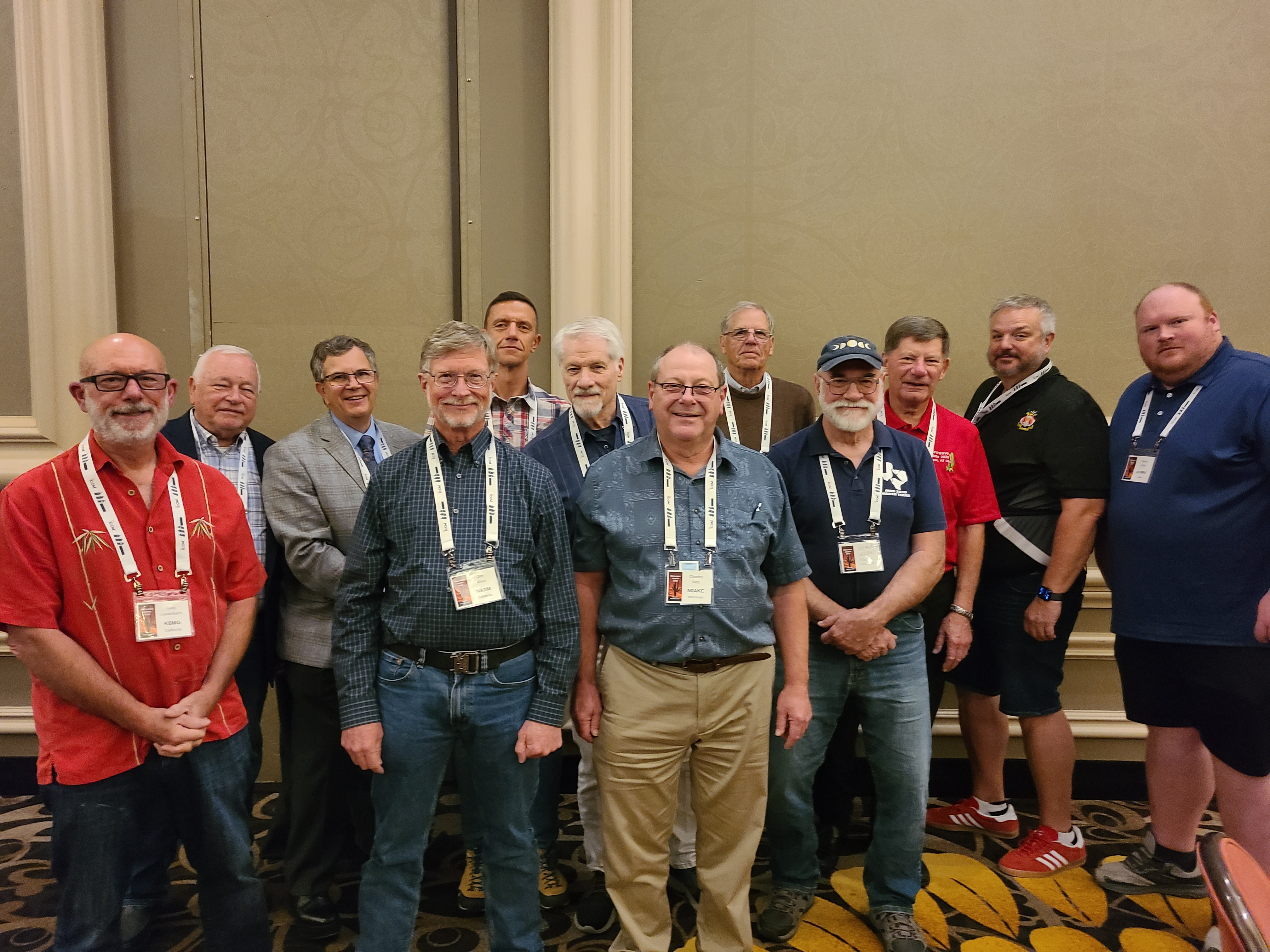 VE4MA 2025 Microwave Update group photo
VE4MA 2025 Microwave Update group photo
VE6TA Grant
I was able to get on 13 cm EME for both EU-NA windows during the ARRL microwave section second weekend, September 13/14th.
Stations worked on 2304/2320 MHz were:
On CW: IW2FZR, WA6PY, G3LTF, OK1KIR, SP3XBO, G4CCH
On Q65: SV3AAF, OH3LWP#, OK1DFC, KN2K#, F1RJ, N0AKC, G4RGK#, K5DOG#, IK3COJ, N1AV, OK1USW#, KN0WS
This takes me to 129 mixed initials on the band. QRM levels getting quite a bit higher now on 2304 and Sirius sat QRM still a problem on 2320 when I am pointed over USA.
I also was QRV on 222 MHz a couple of times with my 18 foot dish and unusual loop feed, see picture.
On Sept 17th both K3SK, and NH6Y in Hawaii were easily worked on Q65. I found after this activity that my transco Y relay seemed to have been damaged. Thankfully KL6M had a dis-assembly and cleaning procedure on his website. After cleaning the contacts my sun noise is back to around 6 dB. Thanks to Mike for posting that. (Key points for me were heating the relay connector with a torch to loosen the glue, and energizing the relay when assembling the connector to ensure it fits in properly.)
On Sept 23rd I tested the new relay out on 222 MHz EME and worked K1WHS with a booming signal and K9MRI with his two yagi station.
Switched feeds to 1296:
10/09 Q65 NC1I, #R1NW, ON4AOI, F5KUG, SP5GDM, #GW4ZHI, #HL2/LY3UM DXCC#87
During Contest;
Q65 #PY0FBS DXCC#88, #K9ZBU, ON4LX
CW VE6BGT, F5KUG, G3LTF, OK1KKD, LZ2US, IK3MAC, NQ7B, WA6PY, VA7MM, KL6M, SP6JLW, DL0SHF, JH5LUZ
Q65 G4RFR, PY0FBS Dupe, #RD4D, IK5VLS, SP5GDM, DK3WG, W2ZQ, K5N, K0PRT,N1AV, WA3RGQ, AA6I, UA9FAD, JS6UJS, JJ3JHP, BA7NQ, KH6FA, #R1NW, ES3RF,N0AKC, AC2AC, W3TI, KB2SA, K3SK, VK4CDI, K6EME, #N4BAA, NY1V, N5BF
I then switched feeds to 432 to test the system prior to the November contest weekend.
10/15 Q65 NY1V
10/17 Q65 OZ9AAR, #OZ7UV, #VE3CIQ, #DL1VPL, #GM8JBJ
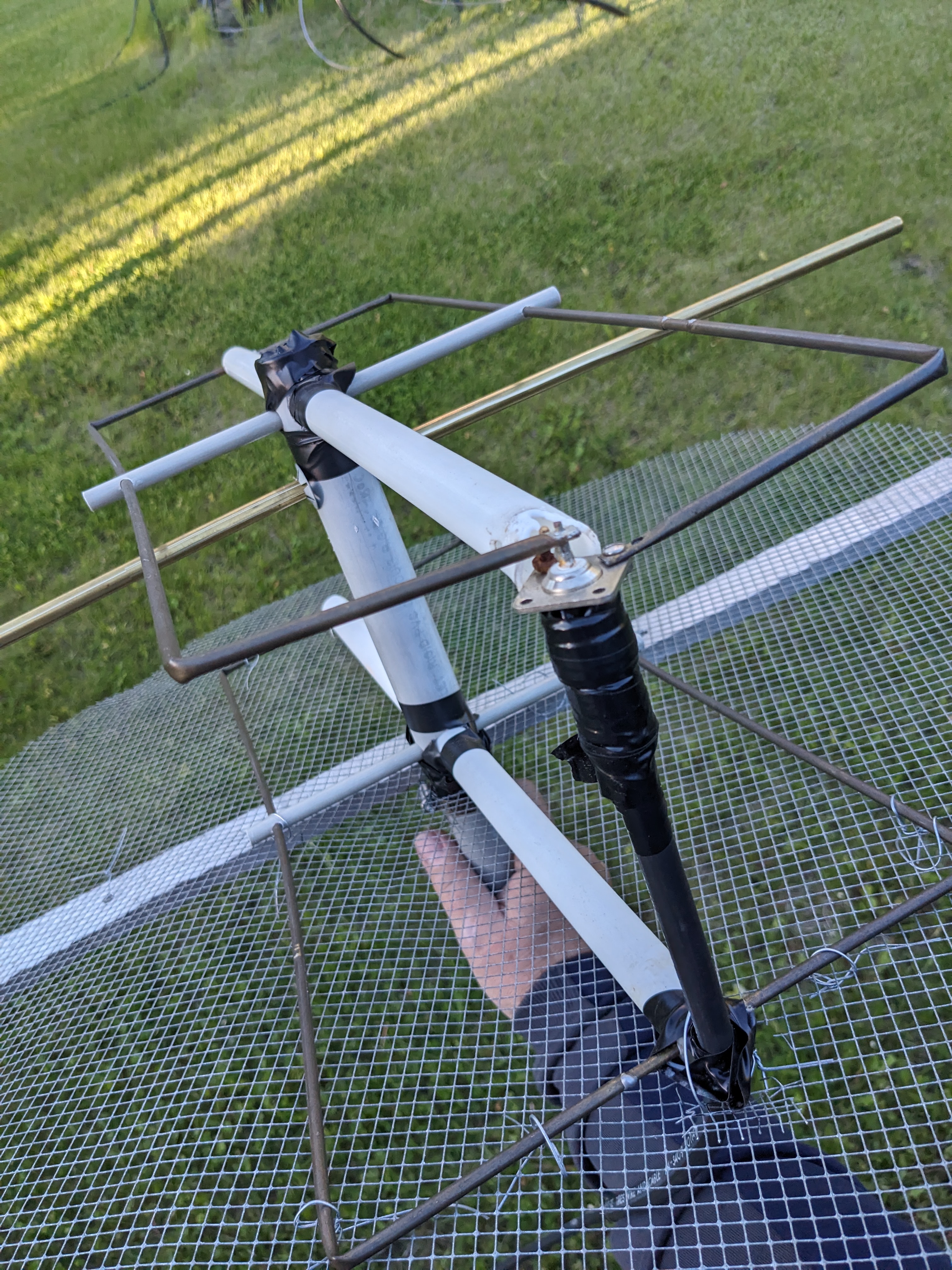 VE6TA 222 MHz dish feed
VE6TA 222 MHz dish feed
VK2CMP Mick
With 4 out of the last 5 months being out in Outback in the 4WD camping I got back in time for the ARRL contest. Not much preparation apart from checking sun noise and pointing the day before. I noticed that the new version 3.0 of WJST dropped while I was away but thought I would leave upgrading until after the 1st weekend. I was very pleased to work 6 new Initial stations over the weekend - PC0A, W4HFZ, K3WM, G4BWP, OZ7UV and F6DRO. Overall lots of fun with plenty of hours of inactivity down here in VK2 in the wee hours of the morning.
The weekend after the contest we had a big storm that broke a lot of branches on a 90 foot gum tree in our yard with a few bending the 70 cm array on the way down. Fortunately with the YU1CF stainless steel elements it will just be a matter of getting out the ladder in time for the 2nd weekend to straighten 5 or 6 elements.
I did plan to complete my portable 23 cm station before the contest but alas it seems true what they say about being busy once your retired and lots of other things got in the way. I should have it completed for the 2nd weekend?
I have been testing the PQL PA on the local 23 activity nights at the home station.
W8TN Clark
I have become active on 23 cm EME for the very first time. Over the last 37 years I have made EME QSOs on 6 m, 2 m, and 70 cm but now with a 2.4 m Sub-Lunar folding dish, I have managed my first EME contacts on this new (to me) band. I was only able to be on for the 2nd night of the October ARRL contest weekend but managed 37 contacts, all new initials, in 17 DXCCs with OE9ERC, OK1DFC, RD4D, OK1UGA, K0PRT, G4YTL, N1AV, SP5GDM, HB9Q, OK1KIR, SM6CKU, ES3RF, OK2AQ, DF2VJ, KB2SA, YO2LAM, OK1USW, DK3WG, PA3FXB, GM0PJD, UA1ALD, WA3RGQ, DL0SHF, OH3LWP, SP3YDE, G4CCH, PA0TBR, AA6I, CT1FFU, KH6FA, W3TI, N0AKC, OH1LRY, AC2AC, K5N, W2ZQ, and JJ3JHP.
I had 7 decodes of PYØFBS as strong as -23 and 12 consecutive decodes of HL2/LY3UM (4 of those at -23) but no QSOs resulted with either of these fine DXpeditions.
Because my QTH is blocked by trees to the East, my operating location is "portable" on my driveway. The equipment is kept on a 3-shelf rolling cart which I wheel out of the garage to operate. I am not able to see the moon until it clears my roof at about 22° elevation but I can see it almost down to the western horizon. QTH is EM98al in the state of West Virginia (WV).
My equipment consists of: a 2,4 m Sub-Lunar folding dish, OK1DFC Lightweight Septum Feed, Sub-Lunar SL-1 Az-El Rotors, N8CQ's WinTrack, IC-9700 w/Leo Bodnar GPSDO, AG6EE preamp, 200-watts from an AG6EE Power Amplifier, and 6,5 m feedlines from M&P in Italy. However, since the station is "portable" there is the possibility that I can operate from other locations.
I operated the next Saturday (2025-10-18) and made 16 QSOs including 13 more Initials: G0LBK, CX9BT, DL4DTU, PA0PLY, KA1GT, I2FAK, KB7Q, NY1V, OK1VUM, N5TM, F5KUG, VK2JDS, and XE1XA. That brings me up to 53 QSOs, 50 Initials, and 22 DXCCs after 2 days on the moon. Boy, am I fired up with those results! I know I worked at least a couple of stations using 1,5 m "Solar-Cooker" dishes and I worked KB2SA with his 1,0 m dish, TWICE! On the first KB2SA QSO reports were: Sent -21 / Rcvd -24. And, I easily completed a Q65-15A QSO with KA1GT, Sent -17 / Rcvd -15.
With the overnight temperatures around 7°C both times, I have now ordered a portable hunting shelter to keep the operating position a bit more comfortable! Weather permitting I will be on for the next ARRL EME Contest weekend and may set up the day before as well.
 W8TN Operating Position
W8TN Operating Position
WD5AGO Tommy
We are set up on 432 MHz for the November leg of the ARRL contest. Remodeled the array from 10 months ago and now have 8 x 15 elements as shown below. I will be operating CW and we will see if a student or two wants to setup and try digital. Email if you want to setup a special CW time during or after the contest. Our moon window is limited, as you can see by the trees, from 15 to 45 deg. E and 35 to 30 deg. W elevation. I figure to keep it up until the new year. The LNA is a new 2 stage, high IP, Cavity.
 WD5AGO 70 cm array
WD5AGO 70 cm array
YO8RHI Adrian
As I promised, some time ago, I made my first EME QSO in 24 GHz - First YO-OZ 24 GHz EME qso! Thanks a lot Peter, OZ1LPR.
My setup: Wavelab XP pallet; DU3T – WR42-Waveguide Switch; DU3T – KLNA 2.2 m dish and TWT RW1127; 25 W at feed (I think...)
Honestly, I was afraid to switch to TX, as I think everyone does when experimenting with new equipment, but I did it and it worked.
I plan for a period of new tests to improve the 1.2 db Moon Noise and Q8 echo test right now. Looking forward to more 24 GHz EME QSOs! http://yo8rhi.blogspot.ro/
 YO8RHI 24 GHz system
YO8RHI 24 GHz system
ZS5Y Derek
I only took part in the ARRL EME contest for about 10 hours in total, the moon was far in the north and I had tree blockage most of the time, only as the moon moved past zero degrees did I start getting clear view of the moon. I worked only Q65 60C and 30B, managed only to work 37 stations.
Because of the moon so far in the north, no stations from Australia or South America was worked, Six USA Stations were worked before the moon set again. Glad to have given a few stations the opportunity to have done a WAC during the contest.
Next ARRL weekend again I will have very little moontime as the max elevation is only 30 degrees here in KF59jr, I will look for some CW stations this time as well.
Of course many thanks to Alex HL2/LY3UM and Bruce PY0FBS for new DXCCs.
1296 MHz Moonbounce with a Double Quad antenna
PA3DZL Jac
Inspired by the experiments with the small 1.0 m and 1.5 m dishes / Solar Cookers and my test last year with a 23 el. F9FT H-pol Yagi (15.8 dBd) I wanted to test a smaller antenna: the Double Quad.
As on the W6PQL website manual to build: This is probably the most simple and inexpensive antenna you could make for 23 cm.
Below a description of the station and the results achieved.
• ANTENNA: Double Quad Gain 7 dBd, Linear H pol. Beamwith 60 degrees! NOTE: Because everyone is circular polarized I lose about 3 dB with linear polarization!
• Power Amplifier: 110 W PE1RKI SSPA, N-switch and VHF Design Preamp 0.5 dB NF
• Short hardline from the Double Quad to the DowKey N-switch with Preamp and SSPA. I did not want to use coax because of the losses and the hardline is nice to hold the light weight Double Quad.
• Box at the bottom 28 Vdc PSU for SSPA (also some counterweight)
• RF Hamdesign Spid SPX-01 AZ and EL rotator, automatic tracking
• Transceiver: Icom IC-9700 + GPSDO lock + W6PQL Sequencer
• Mode used for these QSOs: Q65-60C
RESULTS: Made 6 QSOs with 4 different stations/initials
• NC1I (6.1 m) -24 Send / NOT a complete QSO, Frank was B-21 with me but could not decode me, this was a first test.
![]() PA3DZL NC1I decode
PA3DZL NC1I decode
1. HB9Q (10 m) -17 Send / R-26 Received
2. HB9Q (10 m) R-18 Send / -25 Received
3. NC1I (6.1 m) -22 Send / R-32 Received
4. UA3PTW (8 m) -22 Send / R-27 Received
5. DL5CST (10 m) -27 Send / R-23 Received
6. NC1I (6.1 m) -26 Send / R-26 Received
• OK1KIR (6.1 m) was NOT a complete QSO, Tonda was B-26 with me, could not decode me.
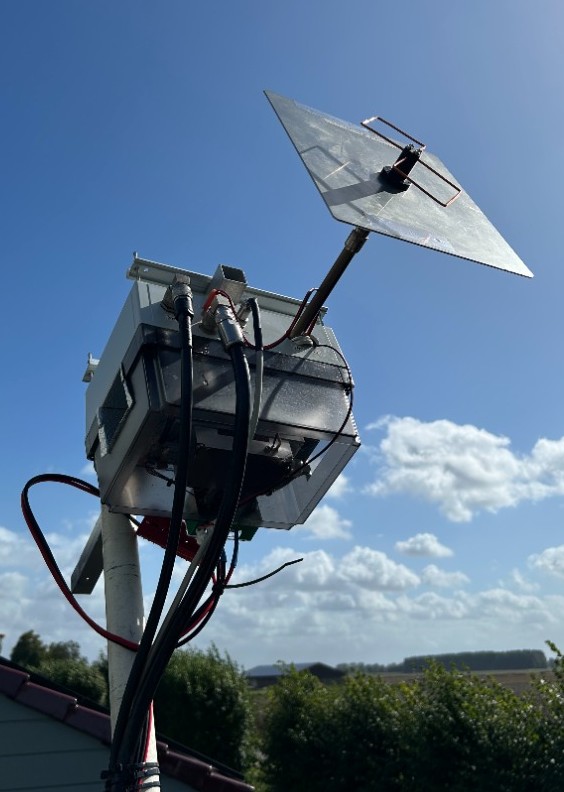 PA3DZL double quad
PA3DZL double quad
Double Quad circa 7 dBd Gain, Linear pol., short hardline (0.1 dB loss) from the antenna to a Dow-Key N-switch, with Preamp and PE1RKI SSPA ca. 110 Watts at antenna, all in the box behind the antenna.
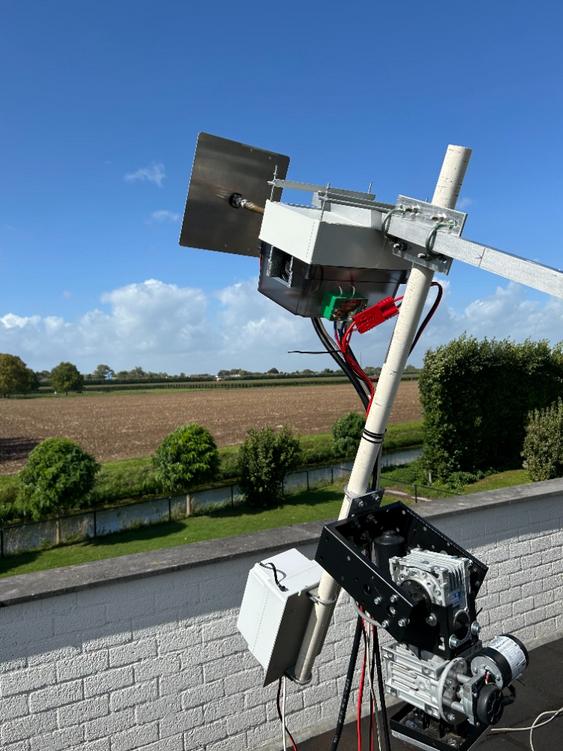 PA3DZL antenna setup
PA3DZL antenna setup
Box at the bottom 28 Vdc PSU for SSPA (also some counterweight) and RF HAMdesign Spid SPX-01 AZ and EL rotator, automatic tracking.
First QSO with Dan HB9Q
 PA3DZL HB9Q waterfall
PA3DZL HB9Q waterfall
 PA3DZL HB9Q WSJT
PA3DZL HB9Q WSJT
QSO with Frank NC1I
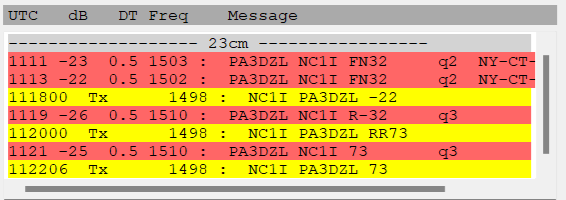 PA3DZL NC1I WSJT
PA3DZL NC1I WSJT
QSO with Dima UA3PTW
 PA3DZL UA3PTW WSJT 1296.095
PA3DZL UA3PTW WSJT 1296.095
Because of QRM we went QSY 1296.095 to .060
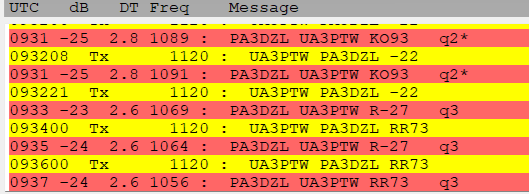 PA3DZL UA3PTW WSJT 1296.060
PA3DZL UA3PTW WSJT 1296.060
If you want to build a Double Quad for 23 cm yourself please have a look at: https://www.w6pql.com/23cm_double_quad.htm
FUNNY 😊 a very funny comment on the HB9Q logger was made by Hannes, OE3JPC 😊 “But most important of this Double Quad success: precise tracking” 😊 😊 I love this humor.